Welcome to a new issue of the Journal of Runic Studies, the premier Malkioni publication for studies into the nature of Glorantha. If you haven’t subscribed yet, please consult with the spirit bound to the appropriate electronic page.
This week Jeff shared an ungodly amount of material online, including some that generated a massive amount of discussion. It was impossible to find the time to follow, collate, and annotate it all — if I missed anything worthwhile, please send it our way!
In fact, it seems to me like the Journal has been growing in size over the past year. This is maybe a sign that RuneQuest and Glorantha have a growing audience, which would be great. However, it’s also a sign that the newsletter may become unsustainable as a mostly one-man job. I’d love to have more guest segments besides the occasional contribution by Joerg, so if you see a note from Jeff, a Glorantha-related video or article, or anything that would typically be featured here and that you’d like to annotate or comment, feel free to send it to me! I’ll be happy to include it in the next Journal issue.
God Learner Sorcery
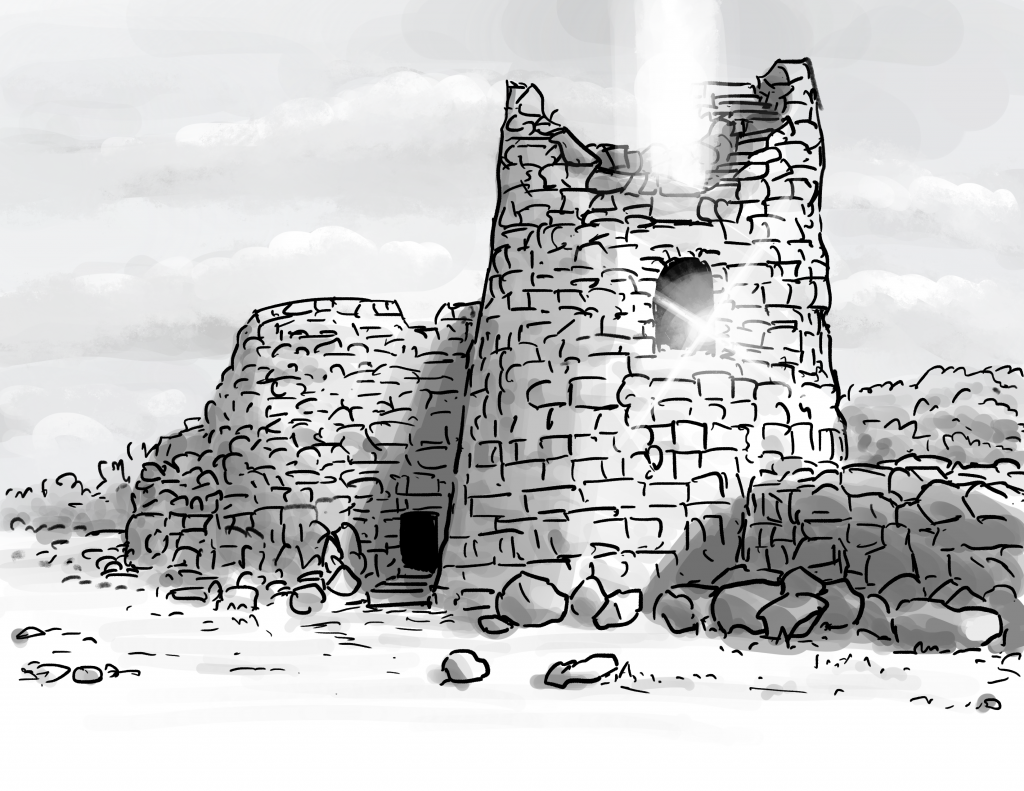
Here is what us God Learners were up to this week.
Chaosium News

Here are this week’s Chaosium news!
Plot vs Fun
This new interview on the Chaosium YouTube channel is about the delicate balance between “story” and “fun” (for a given definition of those terms). Jason Durall answers the hard questions with some interesting points, and it most definitely relates to the “MGF” (“Maximum Game Fun”) pillar of RuneQuest.
VTT Design Exploration for Skills
MadBeardMan is still sharing updates on the development of RuneQuest’s Fantasy Grounds module. The current exploration is about having two “modes” for the character sheet, one for creating and editing the character (where point breakup is visible), and one for playing (where only the final total is visible).
I like this, and several other VTT systems work like that, including the official Call of Cthulhu module in Roll20.
Jonstown Compendium

The Jonstown Compendium is Chaosium’s community content program for all Gloranthan games, hosted on DriveThruRPG. Disclaimer: all the relevant links are affiliate links that hopefully will let us cover some of the hosting and maintenance costs for the website and podcast! Thanks for using them!
Highways & Byways
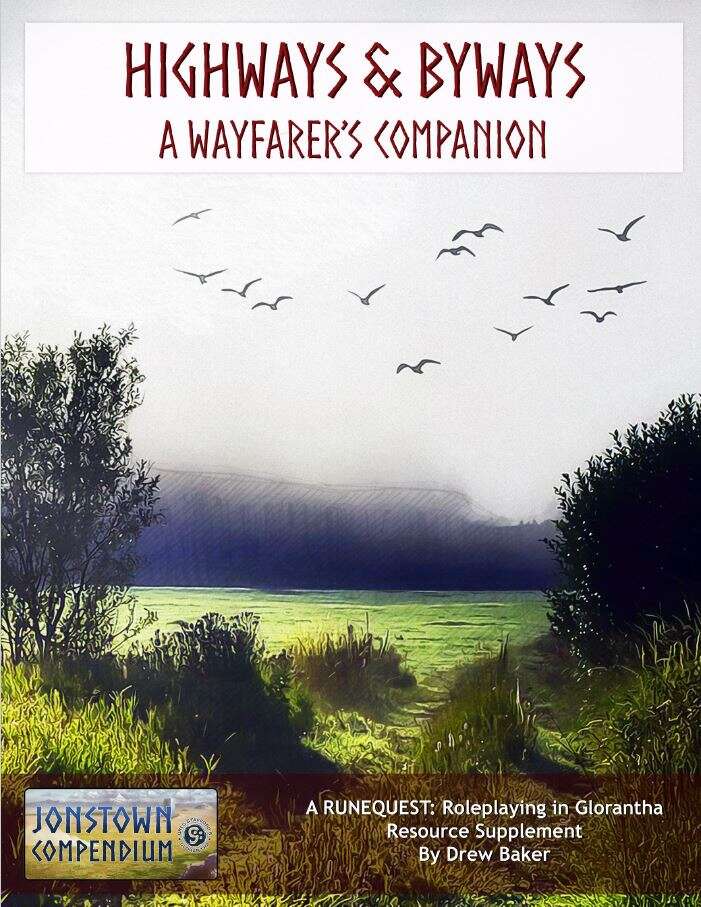
Drew Baker has released a 106 pages book on travel in Glorantha! I love the opening sales pitch:
“We leave at dawn and travel on the road from Boldhome to Clearwine!”, a simple statement but one loaded with questions and the possibility of adventure.
What time is dawn?
How long will the journey take?
Is there even a road to take or will the party have to travel overland?
The book contains information such as travel speed, sunrise and sunset times, trade destinations, and… maps? Maps! Ok, I’m buying this, it’s got maps in it.
Best of Print Sale

DriveThruRPG is running a “Best of Print” sale and six Jonstown Compendium items have been selected: The Black Spear, The Company of the Dragon, The Armies and Enemies of Dragon Pass, Secrets of Dorastor, The God Skin & Mad Prax (aka Sandheart Volume 4), and Citizens of the Lunar Empire. You get 10% off on the POD!
Sneak Peek at Beer With Teeth’s Next Praxian Entry

Diana Probst shared this wonderful scene of a Bison Riders camp, from the next Beer With Teeth scenario.
Jeff’s Notes

Jeff Richard, the current mastermind on everything Gloranthan at Chaosium, is often posting notes and thoughts on the RuneQuest Facebook group. Here’s our curated list from the past week. A partial archive of these sources is compiled on the Well of Daliath.
Cults and Game Balance
Nothing like a bit of controversy to start the week!
One thing about RuneQuest and Glorantha that some find it difficult at first is that the cults and occupations are deliberately not balanced. Orlanth has more and better magic than Waha. Or Storm Bull for that matter. Yelm has far more and better magic than Yelmalio or Polaris. Ernalda or Dendara are vastly more powerful than the Grain Goddesses. Humakt’s fighting magic (True Sword, Sword Trance, Shield, and Sever Spirit) makes many other war gods look laughable.
And that is just fine. Some cults have better magic. They survive because of social cohesion, tradition, etc.
The RuneQuest rules just try to model the setting mechanically (ironically enough, given the common rejection that RuneQuest is “sim-Glorantha”). The setting, on the other hand, was not originally design for roleplaying games: it was done as an intellectual exercise, a background for unfinished stories, a base for a board game. In this setting Orlanth and Ernalda are powerful, so the vast majority of people belong to those cults (and, possibly, vice versa!) It makes sense to me that world-building and mechanics reinforce each other — although of course there are many other ways to go about it, and RuneQuest is only one of them.
I think the problem is actually about gameplay expectations. Cults of Terror was very clear about this: it provides these “evil” cult write-ups but they’re NOT for player characters! Other cults are not so obvious. People might complain that the Dayzatar cult “sucks” because you can’t do much. It makes sense setting-wise, but is it meant to be played? If so how? Another more common example is the Yelmalio cult, which in the setting is the cult of mercenary phalanxes. Again it makes sense in that light (ha ha), but how do you justify a single Yelmalion going on adventures with a rag-tag team of other cultists? People complain that Yelmalio isn’t a good enough fighting cult compared to other fighting cults, but why did they even think that Yelmalio was supposed to be as good as (or better than) these other cults, when Yelmalio is actually about something else?
It’s a cult perception problem, and in my opinion that’s only fixed with the designers being more transparent about what the cults are supposed to be about. I’m convinced that some short “Why join this cult” and “Using this cult in game” sections for each cult would dramatically reduce criticism that currently sounds like it’s about “game balance”.
Another thing – not every human activity has a Rune spell connected with it. And some activities that do have Rune spells connected with it have only a few well-trod myths. The new heroquesting rules help show how cults form and change in Time – needless to say it is not as easy as some assume, and yet happens far more often than others seem to assume!
Yes! I felt very stupid in one of my very first RuneQuest games when I wanted to have some Yelmalions attack and burn things down, but I was like “no wait Yelmalio doesn’t have fire magic“… it took me an embarassingly long time to realize that they can set fire to things the old way… Lo and behold, the Yelmalions were shooting flaming arrows (the non magic kind) and the Alone Confederation was burning.
Cults of Differing Power
Here’s a related topic, but going more into worldbuilding:
So as we have noticed, the RuneQuest cults are deliberately not balanced. Some cults have way more magic – and effective magic – than others. Now that was part of Greg’s vision – but why?
One way of answering that is to look at the history of Time. At the Dawn, most people worshiped what we would call Spirit Cults. They provided a handful of Rune Spells at best (maybe not even Common Rune spells). These spirit cults are what carried those people through the Greater Darkness and Grey Ages that preceded the Dawn. Think of cults like Oakfed, Diros, Telmor, Rathor, Black Fang, Frog Woman, Grain Goddess, Lightning Boys, Yinkin, etc. and scatter them across Genertela.
All of these spirit cults are pretty weak. Lightning Boy, for example, provides Lightning. And that’s about it.
But in Dragon Pass, we have a group of cults called the Lightbringers or Theyalans. This includes early versions of Orlanth Adventurous and Orlanth Thunderous, Ernalda, Issaries, Eurmal, Lhankor Mhy, Chalana Arroy, Humakt, Yelmalio, etc., as well as cults like Kyger Litor, Zorak Zoran, Aldrya, etc. At this time, all of these cults have a comparable assortment of Rune Magic (but remember Orlanth has two cults!).
The word “Theyalan” literally means “People of the Dawn”, according to Jeff, with “Theyalan”, “Lightbringer”, and “Orlanthi” being commonly used interchangeably.
The Theyalans send out speakers to the people of Genertela. They show them their gods and teach them how to reach them. In some cases, they show that the spirit cults are accoutrements or aspects of the greater gods. Lightning Boy is proven to be one of the Four Magical Weapons of Orlanth Adventurous. The Grain Goddess is proven to serve Ernalda. And so on. In other cases, the spirit cults are shown to be related to each other. The Urox atop Stormwalk Mountain is discovered to be the same god as the Storm Bull of the Desert Wind, and the Block is revealed to be even more important than Stormwalk.
It would be interesting to play a couple adventures set at the Dawn, where the characters are Theyalans who meet isolated communities. The players would need to complete various magical challenges to prove that these communities’ spirits are sub-cults of the broader Lightbringers cults. I’m sure there’s a few interesting plots to write there.
Within a few generations, we have a diverse kaleidoscope of cults. Some are growing tremendously through syncretism, identification, and challenges – Orlanth and the Lightbringers, Ernalda, and so on. Orlanth Thunderous and Orlanth Adventurous are realized to just be aspects of the same god. That kind of thing.
But we also still have these little spirit cults and lesser gods. People still worship them because they fill some need, even if that need is largely tradition.
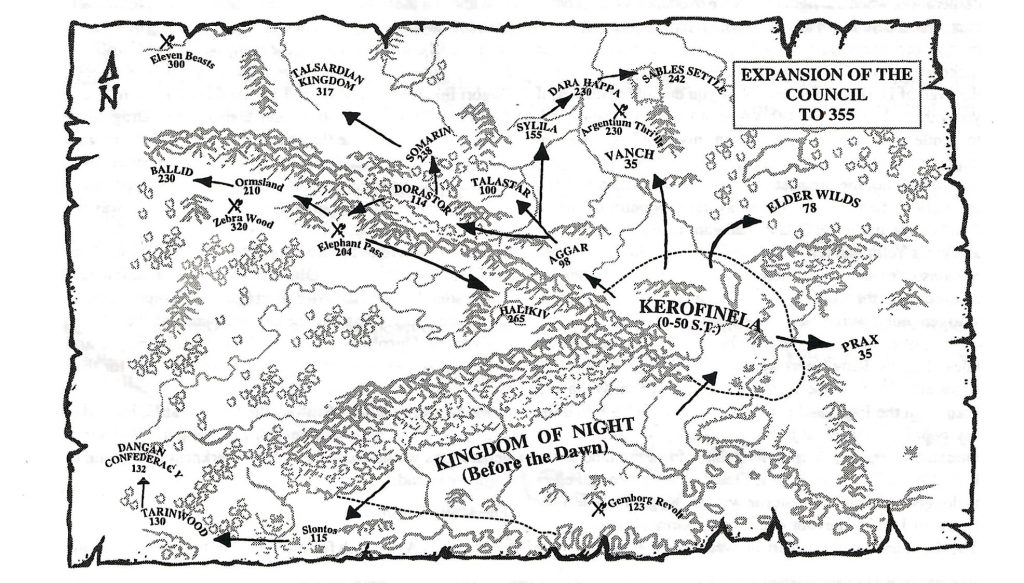
Some gods that were fantastically useful in the Grey Age and at the Dawn remain popular – despite their comparatively weaker magic. Yelmalio is a good example of that. Yelmalio survived the Greater Darkness where the other gods did not. He showed people how to survive in the Darkness, even though his magic was not great. And his cult has always been tenacious and socially cohesive.
Meanwhile in Peloria, we have a Yelmalio horse cult worshiped along with deities like Polaris, Shargash, Hippoi, etc. ruling over a population of Lodril and Grain Goddess and River Goddess peasants. They kill the Theyalan missionaries they find within their realm and this leads to war between Dragon Pass and Peloria.
Eventually the Dara Happan lesser nobility rebel against their horse lords. The Pelorian Yelmalio cult is torn between factions. And a Dara Happan nobleman gathers magical accoutrements and enters the Hero Plane to ascend the Pillar of Yelm, the lost Sun God. He is acclaimed Emperor and reveals his god is the returned Yelm, the Imperial Sun, a god that previously only the Pure Horse People priesthood could contact. Unlike Yelmalio, Yelm has LOTS of magic. He’s got Sunspear, Trueshot, Shield, and plenty more. When the Dragon Pass armies defeat the Horse Lords, this new Dara Happan Emperor negotiates peace and neutrality with Dragon Pass.
But the Orlanth cults recognize his god – it is Yelm the Emperor, who Orlanth slew with Death. And worshiping Yelm places you under the authority of the Emperor, Yelm’s regent in the Mundane World. So most folk in Dragon Pass stay loyal to Yelmalio. As do many of the horse lords, who flee to Pent with Yelmalio aka Kargzant.
So now we have a wide range of cults. Some have only one or two spells, some have more than a dozen or two! This process continues over the next two ages. Sometimes cults collapse or contract, like what happened to Yelm during the Second Age, when Yelm was defined by what he was not. But usually, these syncretic agglomerations were lasting. Orlanth gained another big aspect when Alakoring brought back the magic of Orlanth Rex in the later Second Age. And the God Learners and Empire of the Wyrms Friends promoted identification and syncretism.
But still some old small cults survived. Yinkin and Odayla still have cults independent of Orlanth, even if they are small and their magic fairly weak. Yelmalio’s gifts were likely more important than his Rune Magic, but even that proved incredibly helpful in fighting against trolls and in contesting with the Orlanth Thunderous cult.
So if we think about this from a setting perspective, of course some cults are going to have better and broader array of Rune Spells. As an aside, the Common Rune Magic array I think is a byproduct of the God Learner/EWF era.
I find it funny that (as far as I can tell) people are generally asking why cult A is not as good as cult B from a game-design perspective, and Jeff explains it from a world-building perspective. As is often the case, endless debates stay unsettled because people are arguing about different things.
The question “why does Yelmalio get only 4 Rune Spells, when Orlanth Adventurous gets more than a dozen?” is rarely a question about the lore and history behind those cults: it’s almost always in the sense of “why are these cults designed with such varying scales of abilities?” I think this is a very valid question for people who come from games where character classes, vampiric clans, wizard orders, archetypes and playbooks are designed to be “equivalent” at least in structure. RuneQuest (not Glorantha!) is different in that regard, but this is rarely addressed clearly for newcomers. The real answer has nothing to do with the lore, and is more along the lines of “because the designers are mostly concerned about translating the setting into a game system, and players are simply expected to pick whatever they like, and ignore what they don’t.” Jeff actually spells it out clearly a bit later like that.
And so if we think about Yelmalio, his cult survives for a variety of reasons:
1. His worshipers are really really tenacious. They have learned to fight as soldiers and have tremendous internal cohesion. Sure they might lose a lot of duels and challenges to Wind Lords, but they win a lot of set-piece fights with tribes! And not through magic, but through things like pike and shield or Kuschile archery.
2. He is not Yelm. Yelmalio is far more easily tolerated by the Lightbringers, and his cult is not a political challenge in the same way Yelm is (even if both cults are equally neutral towards Orlanth). His cult can happily exist as an autonomous minority.
3. He has a long tradition of existence. The Delta House rule is real.
4. He fills an important niche. He is a Sky Cult that can coexist with Earth and Storm as peers. He is really good against fighting trolls and the darkness. Elves dig him.
The first point, to me, raises again the question of whether it makes sense to play a Yelmalion that is alone and away from his phalanx. The Yelmalion player must count on the gamemaster to bring that tremendously cohesive phalanx of Yelmalions into the story so that the character can shine in those set-piece battles, for instance. Of find another way to make that character shine (ha ha), for instance by bringing large amounts of trollkin.
Of course, this is basic gamemaster responsibility: if a player plays a talkative merchant, you need to have talking scenes at the market every now and then, and if another player plays a hunter, you can’t set the entire campaign in the city. Hopefully, everyone at the table has matching expectations about what this or that cult is actually about, and what kind of spotlight the gamemaster will bring for them.
Yelmalio for example provides 4 special Rune spells, all common Rune spells, 2 associated Rune spells, plus gifts. His magic is good for seeing in the darkness, getting rid of the darkness, getting rid of clouds, commanding hawks, blessing crops and healing body. His gifts give his followers an edge, potentially a serious edge.
Now Greg was very pleased with Yelmalio precisely because his cult isn’t that magically powerful in comparison with Orlanth or Humakt. But Yelmalio offers something quite important – a tale about being the Last Light in the Darkness. Yelmalio survived the Greater Darkness, even though he was very dim by the end. He was there to greet the return of the Sun and the other gods.
And to me that is a powerful thing.
I actually asked Jeff about how writers should approach the translation between the lore (what happened in the myth) and the spells and abilities you get. For instance, Yelmalio’s stories include a lot of “persevering” and “surviving at all costs”, and yet he doesn’t provide his worshippers with any sort of “magical resilience” spell or ability. At first I thought it might be because a Rune Spell for that would undermine what Yelmalio and his followers accomplish and stand for, spiritually and narratively speaking. But it’s actually not the case — I was interpreting the myth “wrong”:
[It’s] because some of these things aren’t magical. Yelmalio didn’t survive because he had a magical ability to survive. He survived because the Light was not completely extinguished even in the Greater Darkness. So actually Sunbright is that ability. Yelmalio can make it as bright as a sunny day, even during the darkest night!
Similarly, I thought Issaries was finding secret passages and optimized ways, but I misunderstood:
Issaries wasn’t about finding secret passages or shortest paths. He opened ways (Passage) and knew the threats on the way (Pathwatch).
Some people might indeed have a different interpretation of the myths (that’s what myths are for, right?), in which case they can devise new and different Rune Spells for this or that deity. But before you do that, another insightful and very interesting point is to consider the position of the deity within the broader monomyth, and whether you’ll create some overlap:
One thing I reject from proposed cult write-ups is stuff along the lines of “Argan Argar was the ruler of the Surface World, right? So shouldn’t he provide some rulership magic?”
And the answer is no. Thanks to Yelm and Orlanth, the position of Cosmic Ruler is filled. Heck, because thanks to there being two claimants for the position, the Sun died and the Darkness happened, so two is enough.
Of course, having overlap between two deities over a given role is also obviosuly what makes things interesting in the Cosmos… anyway, this is all good stuff if, like me and my players, you think about small local cults for your campaign:
This gets into a general writing issue. If you want to pitch a cult writeup to me, remember that most cults are not Orlanth, Ernalda, etc. Most Genertelan cults that have not yet been written up are hopped up Spirit Cults which might not even have Common Rune Magic. Or they are actually more or less cults we are already familiar with but with an unfamiliar name.
Moving on to Waha as an example:
Waha doesn’t have a lot of powerful magic. But like Yelmalio, he survived the Grey Age. He defines what it means to be a Praxian and thanks to him men and herd beasts can coexist in Prax. That’s frankly enough for him to be one of the two main cults in Prax, even if he provided NOTHING ELSE.
But Waha does provide Axis Mundi, Discorporation, Dismiss Small Earth Element, Shield, Summon Spirit of Law, Summon Small Earth Elemental. He has a shaman path and a Rune Lord path. And honestly that’s enough.
One thing that struck me when I started looking into RuneQuest is that, unlike most games where you pick a gameplay archetype (fighter, healer, netrunner, berserker, pilot, etc) (or a combination thereof), here it’s more about picking a cultural role. Waha is a good example of that: I can’t really define him and his worshippers in any sort of game-related way. He’s not really a fighter nor a hunter or whatever else — so the main reason to pick Waha as your cult is because you want to be a part of the survival leadership tradition of the Praxian nomads, or something like that.
And so if you are a person who wants a cult with a broad range of spells, then pick one of those. Orlanth, Ernalda, Humakt, or the other Lightbringers. Or Maran Gor, Babeester Gor, etc. And if having a relatively short list of spells isn’t your thing, then the answer is – don’t pick a cult with a short list of spells.
There, see? Jeff finally said it plainly. Time to leave the gameplay considerations and have a parting word:
Also what I hoped to show with that little essay is how much Gloranthan cults change with Time. The Orlanth Thunderous and Orlanth Adventurous CULTS of the First Age had lesser access to magic than the Orlanth CULT of the late Third Age.
Wherever the Theyalans went, they brought their cults and gods. So wherever you see those arrows [in the map above], you had awareness of the Lightbinger cults in the early First Age.
Import People of the Morokanth Tribe
All major Praxian tribes were featured last week except for everybody’s favourite sentient tapirs. This is now fixed:
The Morokanth are nonhumans, and they outrage the other people of the Plains by herding human-descended Herd Men, who are, in fact, herbivorous and unintelligent. Man being a social animal by instinct, the Herd Men cluster in large herds, and Morokanth clans tend to be large in consequence. They are far more gregarious than the solitary High Llamas and Rhino Riders. Their liking for company is one factor that has kept them alive on the plains, for the Morokanth are a social folk and always have large numbers of brothers and sisters on hand for any fight.
Morokanth culture follows the traditional Waha-Eiritha style very closely, as it is one of their claims to legitimacy in the plans. They are always quick to point out when one of their human coreligionists strays from the Waha way. Many follow the ancestor worship of Grandfather Morokanth, who is equivalent to Daka Fal, and there is even a dark Zoran Zoran cult. Several Morokanth have embraced the official tolerance of the Lunar Empire and use it to further their own political goals.
The Morokanths are one of those things that, I think, everybody loves about Glorantha, even though everybody also has a different take on it. A species-swapped tribe of sentient animals herding unintelligent humans is a great elevator pitch to get any fantasy lover to tilt their head and ask for more information.
The Wakboth is in the details, though. Gloranthas will vary based on what people think the rules of Waha’s Covenant were, whether the Morokanth cheated or not, and so on.
As a reminder for the new people in the audience, the Survival Covenant was something that the god Waha came up with while trying to figure out how all his people were going to survive after the land god Genert was killed by Chaos, and Prax became mostly barren. The general idea was to have a “contest” to split people in pairs, each one made up of those who eat from the land, and those who eat from the former. Or something like that… people interpret the text differently sometimes. The humans won most of the contests (against the bisons, high llamas, etc), except the one where the Morokanth won…
Unlike the other Major Tribes, Morokanth do not ride their herd animals, although some chieftains have trained Herd Men to pull in chariots or carry them in palanquins. Morokanth keep intelligent human slaves in addition to their herd-men.
In combat with other nomads, they use claws and sometimes spears to good effect. They favor the tactic of hamstringing mounts, then using their superior strength and claws on the ground versus the dismounted nomads. They are masters of using every nuance of the terrain to conceal themselves for ambushes, and often use night attacks on their tribal foes. They also use mercenaries and Awakened Herd Men as infantry.
The Morokanth accepted the Lunar presence in Prax as just another pushy human tribe and they dealt with the Empire as they would with any non-Morokanth – warily. Although many Morokanth fought against the Lunars at the Second Battle of Moonbroth, the tribal leaders are deeply suspicious of the White Bull Movement, even as many Morokanth warriors join it. Argrath’s noted dislike for slavery is an additional point of contention with tribal leaders.
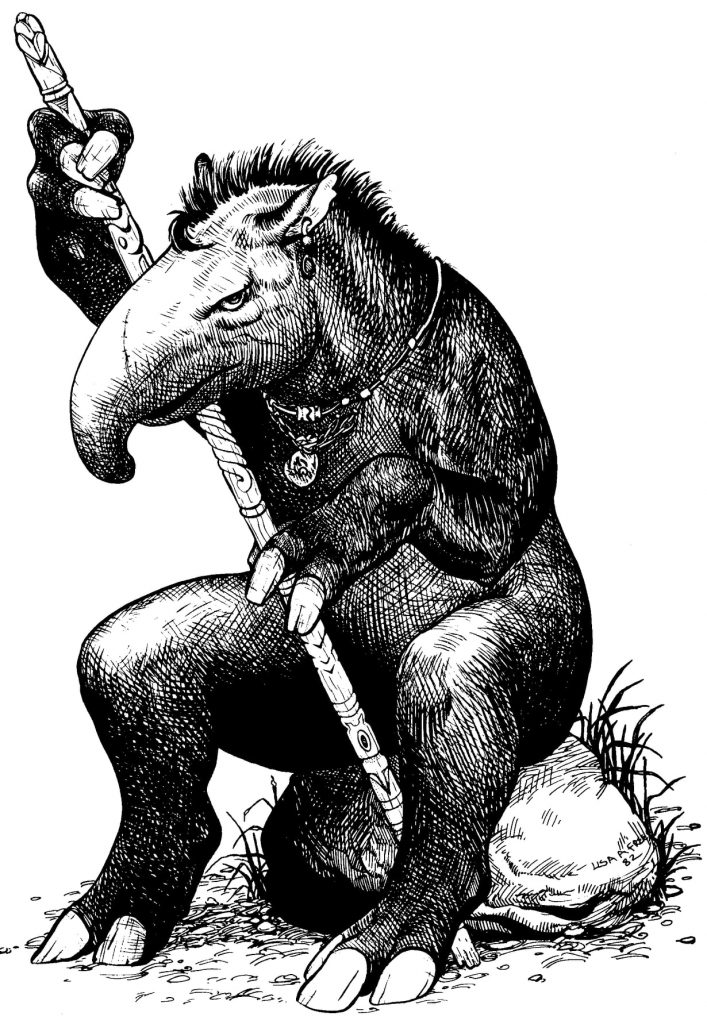
One of the points of contention is about the Morokanth’s diet. Some people say they should be vegetarians, others that they should be omnivores. But even in our episode on Nomad Gods, in which David Scott was advocating for the former (as per Greg’s own wishes), he still said that Morokanth ritually eat meat at least once a week… which makes them omnivores in my book (I live on the West Coast, so I can guarantee you that none of the local vegetarian hipsters here would accept that!)
In fact Jeff clarified this point:
Morokanth are essentially sapient tapirs. They ritually eat meat, but normally eat fruit, berries, and leaves – which their herd men herd them gather.
A tapir needs about 30-40 kg of food a DAY. Given their size and the slow breeding cycle of hominids, there is simply no way that herd man flesh can be their main source of food.
The Morokanth are effectively omnivorous, although they mainly eat plant material. Herd men are ritually eaten as part of their Waha-EIritha ceremonies, after being killed and butchered with the Peaceful Cut. Given that this is usually twice a week, it means they supplement their diet with meat.
For what it’s worth, note how Jeff increased the Morokanth’s meat consumption to twice weekly.
Some people might give Morokanth an even more balanced diet (Sandy Petersen does, as far as I know, and I certainly would too), but it gets interesting in the more general context of Praxian diets. Do, say, Bison Riders mostly eat bison? (their own or that raided from other Bison Rider clans.) Or do they mostly eat other animals? (because they raid the other tribes more than their own tribe and, having not much use for non-bisons, they eat those first.) Figuring this out impacts whether Morokanth would mostly eat herd men or mostly eat the other Praxian mounts (at least outside of their rituals…) More importantly, if impacts whether the other Praxian tribes eat herd-men! How awkward and creepy do you want you Prax to be?
Michael “MOB” O’Brien has an interesting take which is based on the Morokanth having indeed cheated during the Covenant:
Because the Morokanth cheated their way to the “Eater” side of the Survival Covenant, they’re still physiologically herbivores. And also like the rest of the “Eaten”, they still lack hands and the ability to manipulate things, and actually get around far better on all fours too. While, as Jeff notes above, the Morokanth do eat meat on ritual occasions (or when goaded by other Praxians) as a means to demonstrate and affirm where they stand in the Covenant, it does not agree with them and they don’t enjoy it.
The other Praxians gleefully love serving up buffalo steaks and the like to Morokanth at intra-tribal gatherings. Lest they be accused of being “cheats”, to prove their bona-fides the Morokanth have to gamely gobble it down.
When human Praxians come visiting the Morokanth, they do get served meat. The Morokanth ostentatiously get served “steaks” too at such feasts, but these are cunningly fashioned out of plant matter. Imagine a 33 ounce rib eye made of lawn clippings and you get the idea.
I like this take a lot, but assuming that the Morokanth cheated at the Covenant because they don’t have opposable thumbs or bipedal-only locomotion sounds a lot like human bias. I mean, we even call them the “Morkoanth tribe”, instead of the “Herd-men tribe”! (tribes are supposed to be named after their animal, dammit!) But I’m absolutely convinced that many Praxian priests are using this logic to “prove” that the Morokanth cheated, so I’m totally putting it in the mouth of some NPCs.
On a pure world-building perspective, I don’t think I need, or want, to resolve this debate in my Glorantha anyway. I’ll probably leave it open forever, unless my players somehow heroquest into the secret Morokanth parts of the God Time, which has very little chance of happening. Right? Right… I think…. shit.
The Morokanth primarily use herd men, and not other animals:
Under the Compromise, one must “ride” one’s primary herd animal. So Bison Riders ride… bison. And not Sables, etc. It would likely be seen as wrong if the Morokanth let another herd animal pull their chariots.
The important people in the Morokanth tribe are:
Egajia Chewer of Flesh, Paps Most Respected Elder
The Most Respected Elder of the Paps is a Morokanth high priestess of Eiritha. Egajia personally negotiated the Armistice of Prax, which ceded control over the lands along the River of Cradles to the Lunar Empire in exchange for promises to stay away from the holy places in Prax. Once this made her beloved by all Praxians, but now many accuse her of having cozied up to the Lunar Empire. She does not trust the White Bull Society, and increasingly fears them. She hopes to remain in power long enough for the White Bull Society to fall apart, as Praxian confederations always do. Until then, she avoids politics to concentrate purely on spiritual matters.
Velakol Surestrike, Waha Khan of the Green Stripe Morokanth
Velakol is an influential khan of one of the more powerful morokanth clans. He led the Morokanth to fight for Argrath at the Second Battle of Moonbroth, but declined to aid him take the city of Pavis. Velakol has led the main Morokanth force in Prax away from the River of Cradles.
Like other Khans of Waha, Velakol is foremost a protector of the herds of his tribe and a raider of the herds of other tribes. When he has the time, his favorite recreations are sports and contests of physical prowess. One way to gain his respect is to best him in such a contest. Velakol possesses a magical thumb on his right forefoot, allowing him comparable manual dexterity to a human.
His special joy is his chariot with its team of four matched herd-men, which he races against teams belonging to other Morokanth. In both work and play his competitive nature comes to the fore. This is his vulnerable point. Though his honor and self-confidence are such that he would not cheat, once his need to win is aroused, he may take chances and make mistakes he would not ordinarily make. Velakol’s bodyguard is Yarin Blackhair, an awakened herd-man who can pass as human.
Kareel Keenclaw, Waha Khan
Kareel is a Waha Khan as wily as he is strong. A once-notorious slaver, he now captures humans for their ransom rather than selling them into bondage. Unsentimental in the extreme, he speaks in a languorous, subtly mocking drawl. He carries two sets of anti-magical bracelets which prevent prisoners locked into them from casting magic of any kind.
Hah! Anti-magic bracelets! We saw them in the Travels of Biturian Varosh, but it wasn’t clear if these were still a thing in today’s Glorantha. It sounds like they might be a rare magical item, rather than a widespread method for slave bondage.
Madam Black, Death Lord of Zorak Zoran
This huge female morokanth is one of the most feared warrior-magicians of the tribe. She is surprisingly cultured, especially concerning troll cuisine, but is also merciless and cruel. She hated the Lunar Empire but has been a sporadic ally of the White Bull at best. Madam Black was given a great troll by the Redstone Zorak Zoran temple, who serves her as a bodyguard and valet. Most of the time she is a lazy glutton, but in combat Madam Black shows surprising energy and speed, tearing her foes apart with enchanted iron claws that can harm spirits.
I love this Madam Black! I might even rename her “Madame Noire”, and give her a New Orleans voodoo witch vibe…
Shukan, Seven Mothers priestess
This extremely intelligent Morokanth is the leader of the Seven Mothers cult among the Morokanth. The daughter of a Morokanth Khan, Shukan joined the cult several years before the Lunar Invasion, attracted to it by its message of spiritual equality among all sentients. Shukan helped persuade the tribal leaders not to participate in the First Battle of Moonbroth and was rewarded by the Lunars with lucrative concessions. Shukan was a friend of the self-proclaimed Duke Raus of Ronegarth. Shukan withdrew from her human allies when Jaldon Goldentooth was summoned, and has managed to keep her followers safe from any reprisals from the White Bull Movement. She now seeks to aid her kinswoman Egajia maintain her position as Most Reverend Elder and tries to undermine the White Bull Movement without earning its ire.
Flarat Spirittalker, Grandfather Morokanth Priest-Shaman
This morokanth from the Green Stripe Clan is a close friend and advisor of Khan Velakol. He maintains continuity with the Morokanth Ancestors. He is strictly neutral in the conflict with the Lunar Empire, caring only about the spirits of the Morokanth and their descendants. He heartily dislikes Kareel Keenclaw, and may befriend anyone who has done hurt to Keenclaw.
Oasis People of Prax
Let’s keep looking at the people of Prax! The major inhabited oases of Prax are Agape, Bigglestone, Cam’s Well, Day’s Rest, Dwarf Knoll, Horn Gate, Moonbroth, and Tourney Altar.
Note: Despite Praxian boasts, Adari, Barbarian Town, Corflu, New Pavis, Pimper’s Block, Sun County and their surrounding villages and settlements are definitely NOT inhabited by “Oasis People”.
You can find all these things on this AAA map:
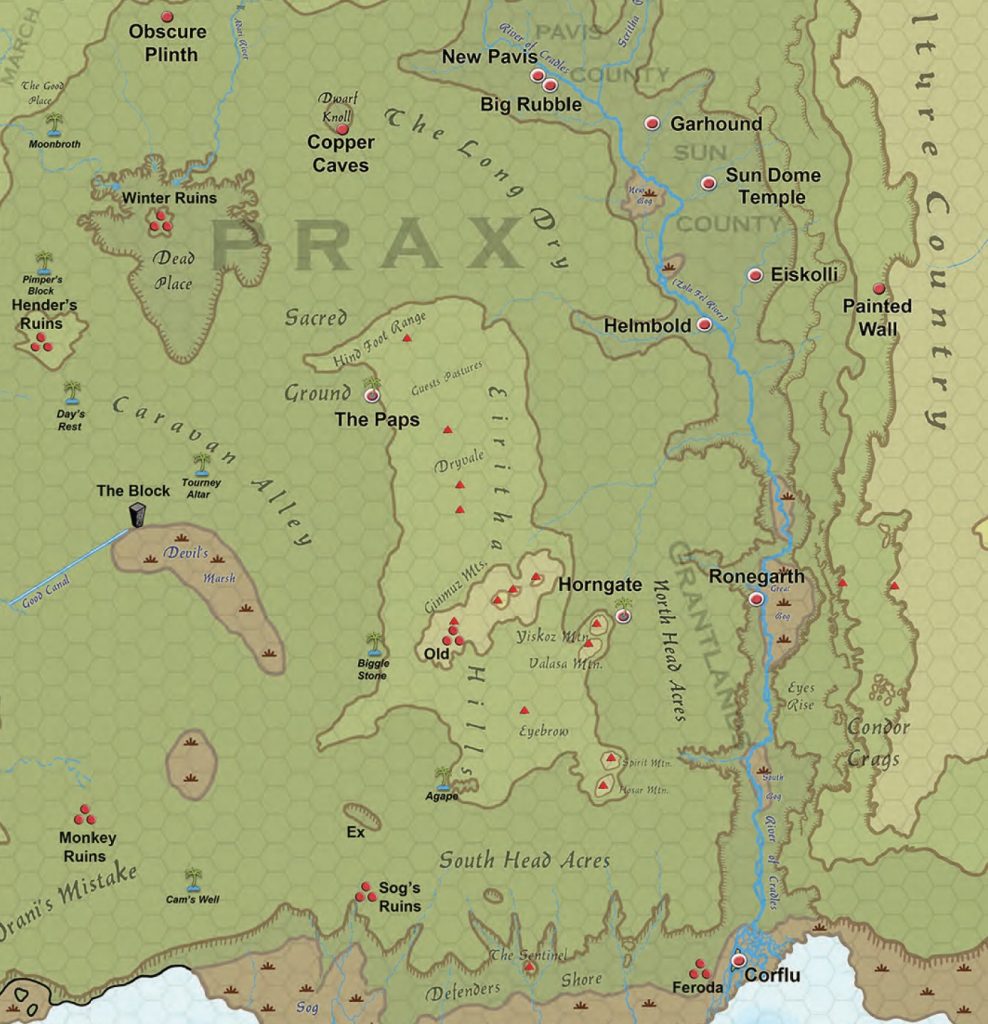
Native farmers are indigenous to this land and have descended from survivors from before the Darkness. These folk have survived bad conditions for centuries. Whenever a conqueror makes peace for a while, they crawl from hidden lairs and farm. When the conqueror fails, they fade again into the earth. They speak their own language, but avidly learn Tradetalk.
The Oasis People are mostly mixed stock, including many blue-eyed people alien to the Praxian nomads. They live in conical huts of dried mud and thatch within the walls, although in the Big Rubble. They grow herbs, dates, grain, and grapes.
The oases of Prax are always fought over by the nomadic tribes who want to “own,” even temporarily, the lush land.
Jeff offers some photographic inspiration for these oases of Prax: Afton Canyon in California, USA, and Papago Park in Arizona, USA.


The Oasis People are treated like slaves or animals by the nomads, as though incapable of organized resistance or of independent thought. The nomads view them as listless and dullwitted. The natives rarely do anything to counter that opinion. They gather, plant, harvest, and so on the way they have since time began. When ordered to do so they will bring foodstuffs and tribute to the nomads who currently own the oasis. Good chieftains will trade with the natives and treat them fairly. Meat raising is generally forbidden to the oasis peoples and so gifts of it are greatly appreciated. They trade foodstuffs or child slaves.
Note that many Praxians consider Pavis County, Sun County, the Grantlands, and Corflu to be just other “oases”. At the same time, the nomads still sing about the Seventeen Foes of Waha that inhabited what is now the Big Rubble, and recall the savage and humiliating defeat they received at the hands of the Sartarite settlers in the Praxian Revolt in 1572.
Dorasar Founds New Pavis
This is how it happened, according to this slightly improved version of the story from Pavis: Threshold to Danger.
In Dragon Pass, the great and wise King Sartar started a splendid dynasty renowned for wisdom and generosity.
A son of King Sartar, Eonistaran the Sage lived in Jonstown. His two sons were raised with their cousins, the princes of Sartar. Dorasar was the younger of Eonistaran’s sons, and he was close to Prince Sarotar, the heir to the throne. He and Sarotar practised at arms, poetry, law and the hunt, and Dorasar was the first to swear allegiance to the prince when he was of age to receive fealty.
To situate all this in time, keep in mind that the Kingdom of Sartar is not very old: it’s less than 150 years old. Eonistaran was born in 1512, Sarotar in 1518, and Dorasar in 1531. With a 13 years gap, I imagine that Dorasar saw Sarotar as a mentor or older brother figure.
Dorasar was part of the Sartarite dynasty, being a nephew of the current Prince at the time, and a cousin and uncle of a couple later Princes. If you have a New Pavis-based game, that means there are maybe one or two undiscovered Sartarite heirs running around in your campaign!
Prince Sarotar fell in love with a woman of the Holy Country. Their love was deep and intense, but a terrible problem kept them apart. Sarotar, by virtue of his royal position, demanded wifely fidelity, while Arkilia, his love, would never take such vows. They had one child, a girl, but Sarotar was slain by her other lovers while attempting to secretly kidnap her.
This love affair and untimely death happened between 1540 and 1546. The story has been carried on in a few ballads such as “Saronil and the Sad Lady” (Saronil is Sarotar’s father), the mournful “Song of Marlesta the Dancer” (that’s the child), or the “Song of Vengeance” (which tells about Sarotar’s brother and cousin’s bloody vengeance upon his murderers).
And this whole thing left traces across the history of Sartar and the Holy Country. For instance, Queen Norina of Esrolia was killed in 1551 by “Sartarite assassins seeking to avenge the death of their prince”. This is of course misleading because the King of Sartar is called “Prince of Sartar”, and Sarotar wasn’t Prince (with a capital “P”) but a prince (a son of the Prince, or King). Ugh. Come on, Greg, get it together.
If you’re wondering what happened to Marlesta, she didn’t want anything to do with neither the Sartarite or Esrolian dynasties and joined the Puppeteer Troup.
Dorasar’s life was destroyed when his liege was killed. Dorasar had sworn to defend the man with his own life, and had only thought to sit at the hand of his lord. Dorasar felt guilty that his prince must depart without Dorasar’s sword in defence. Dorasar decided to make a place which would keep Sartar’s secrets and lifestyle pure and untainted by such inhuman traditions.
Dorasar was a clever man, much travelled. After long scouting, he settled on the wilds of Pavis. He returned to his clan with treasure and tales of wonders in the legendary Rubble of Pavis. He found many who would commit their bodies or money to his first expedition, one of exploration and plunder. Many who went returned wealthy.
Again, to provide a few dates, this first expedition happened some time in the late 1540s.
There was trouble in the land in those days, and many people wanted to withdraw before the encroaching Lunar menace. When Dorasar and his friends led a second expedition to settle in Pavis there were many volunteers.
The “encroaching Lunar menace” is referring to the Lunar Empire moving onto the Orlanthi Kingdom of Tarsh. At this point in time, Tarsh was actually enjoying a short-lived success of anti-Lunar rebellion, with Palashee Longaxe currently ruling the place with the support Sartar and the Shaker’s Temple. But a few years later, Palashee would be dead, and Tarsh irrevocably Lunar. I think that Dorasar saw the writing on the wall when he started looking eastward for a place to settle.
Dorasar did not approach this new land as a stranger, without plans or friends. His wisdom was evident in his foresight. While upon the plains with his people, he travelled with Gorgar Bluecloak, a sable chieftain and friend. Together they drove off a large warband of impala people and reached the river.
At the river, several others came to meet them. There was Ingilli the Fisher, who came with many people from the banks and mouth of the river to aid him. Too came Varthanis Brighthelm, a lord of the Yelmalio county which held lands down river, and sought allies against the Impala tribe. There was Olgkarth Arrow-eye, of the Zebra people who was made king of that tribe with Dorasar’s help. Finally came Ginkizzie, king of the dwarfs of Pavis, who spoke for the inhabitants of the Real City and the Flintnail cult.
All these folk sat down and counted their followers, added their wealth, boasted of their exploits, and determined what each would receive in the city to be built. During this time many folk came out of hiding from the valley and asked for refuge. A great troll attack was fended off. Finally, decisions were made and everyone agreed: oaths were sworn, pacts made, and promises spoken.
Dorasar staked out the limits of the city walls. Others performed parts in the rites as well. The council met in the centre, swore their oaths, and founded the city. The walls were begun, the streets laid out, and the buildings started.
Dorasar was chosen as King and became ruler of the city for life, but none of his heirs could take the title, nor could any other. After Dorasar’s death in 1579, the city was ruled by a council of its leaders, each aware of the others and of their part in the whole. The Pavis cult gave guidance.
New Pavis was founded in 1550. Dorasar lived as King until 1579. His body was burned, in Orlanthi fashion, though some say his spirit remains to protect the city in need.
It’s interesting to realize that New Pavis is a pretty recent development. The “old” Pavis (now known as the Big Rubble) is quite old (it dates back to 850, and was built around the older Robcradle which was founded in 780), but New Pavis is only 75 years old. It’s a new trendy city with many business opportunities to all young hipsters!
Also notable is that Dorasar was at most 20 years old when he founded New Pavis… what have your adventurers accomplished by the time they get 20? They got a horse and killed some broos? Good for them!
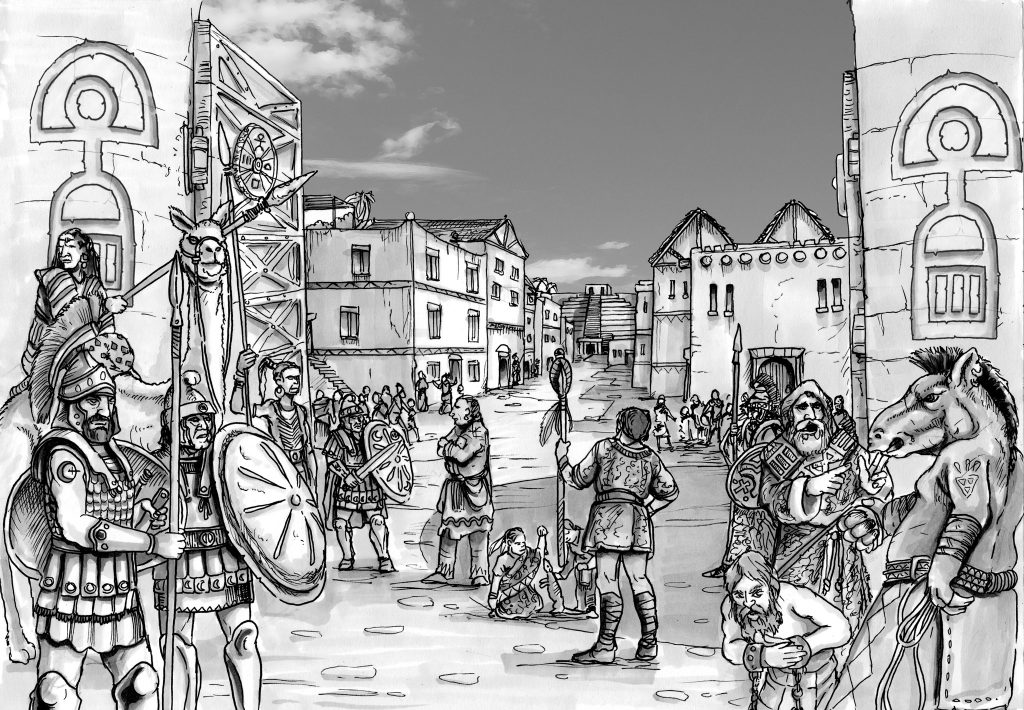
During his life Dorasar ruled strongly and well. His city was not part of the kingdom of Sartar, though it swelled with refugees from that war torn land. His farmers went up and down the river, expanding their holdings and remaining friendly with the nomads. The nomad irritation with the civilized rules of Pavis exploded in 1572 when those within the city revolted and tried to open the gate to allies outside. The plot was poorly planned and defenders moved to prevent the attack before it began. There was savage bloodshed as the nomads were defeated. They lost many rights because of that fight, for they no longer have a member upon the council, nor may they ever camp on the south of the river within thirty kilometres of Pavis.
The wearying troubles between the kingdom of Sartar and the expanding Lunar empire sent many refugees to distant Pavis. The city kept aloof and sent no warriors, though individuals certainly went on their own to fight the distant foe. Many Sartarites came just after Sartar fell, in 1602, when it seemed Pavis was safely out of the line of the Lunar advance.
But in 1610, after being turned back from the ports of the Holy Country, the Lunar army marched eastward towards Pavis. Valiant nomads gathered forces to resist the chaos foe, but were decisively defeated and slaughtered. The Lunar army marched against Pavis.
And of course the Lunars took Pavis, holding it for more than a decade. But in 1624, Argrath Whitebull unified the tribes of Prax and defeated the Lunar Army at the Second Battle of Moonbroth. He then proceeded to liberate Pavis, and was eventually acclaimed King of Pavis… you know… the title that Dorasar said nobody could have. Oh how times have changed.
The Lunar Occupation of New Pavis
While we’re in New Pavis, let’s rewind back to 1610 and look at the Lunar occupation:
As we all know, in 1610 New Pavis resisted the Lunar Army for a single day, then opened its gates to the besiegers. There was mutiny, but the ringleaders were caught and slain. Those who would resist were butchered systematically, or killed impromptu, depending upon your point of view. The conflict with the Yelmalio ruling family was a surprise to many: the purge of Dorasar’s kinsmen was less so.
For the next 14 years, the city has remained in Lunar hands, though the original army went home long ago. The first Lunar Governor, Sor-eel the Short, maintained peace with the barbarians and the trolls, and keep the city’s coffers full. Although the Orlanth cult was suppressed during this period, the political clout of Orlanth’s priests allows some of them to remain in the city despite the repression.
Sor-eel also preferred to allow the city to more or less govern its own affairs, although he reserved the right to intervene directly in civil or criminal situations as he pleased. A polite fiction was maintained that the city council was independent of the occupation forces, and Lunar rule was generally benevolent and unoppressive. Sor-eel had a sincere interest in the well-being of the city and he tried to cooperate with and coop the local authorities.
Again I find myself looking for dates to figure out when things happen… this next chapter starts in 1622:
Sor-eel was dismissed when Tatius the Bright became Governor of Dragon Pass, the result, no doubt of changing Imperial politics. His successor, Halcyon var Enkorth, was a very self important man, and had been an aide of the Provincial Overseer. Halcyon was not trustworthy, found it easy to lie through his teeth, would stab a friend in the back for a decent profit, and stole from the elderly for fun. Needless to say, the Provincial Overseer considered him perfect for the job. He had previously been responsible for the Balazar Precinct, and had also carried out illicit covert missions in the Holy Country on behalf of the Provincial Overseer. Although greedy and duplicitous, Halcyon was appointed for his personal loyalty and utility to the Provincial Overseer. He was accompanied by his right-hand-woman Marusa the Shrew, and quickly brought Gim Gim the Grim into their counsels and confidence.
Stole from the elderly for fun? Hey, that reminds me of something.
Halcyon’s previous position in the Balazar Precinct means that there’s a lot of material on him in Griffin Mountain. He has… some interesting bits of backstory.
Griffin Mountain was originally a fantasy campaign set in a custom fantasy world, but Greg Stafford asked the authors to move it to Glorantha. Jennell Jaquays, co-author and illustrator of Griffin Mountain, shares that this is when Halcyon was added:
Halcyon var Enkorth was not in the pre-Gloranthan version. He came when we added the citadels at Greg’s request and that there was a Lunar presence in one of the citadels.
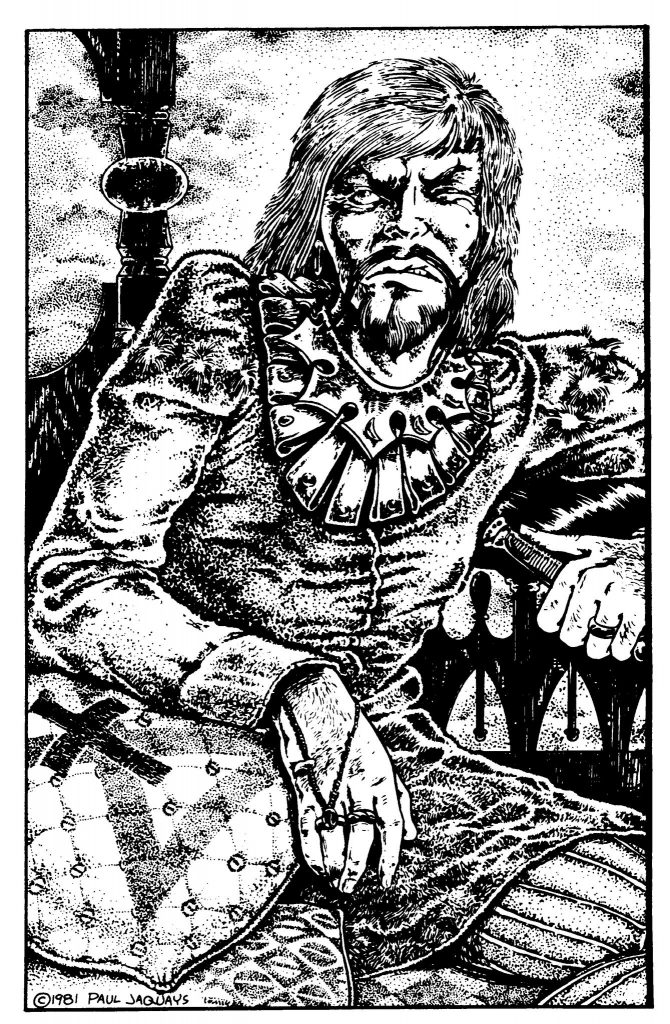
Back to Halcyon’s Pavisite promotion:
For the next three years, Halcyon’s regime was ruthless, thuggish, and thoroughly disreputable. However, he retained support in Boldhome and Mirin’s Cross because of his willingness to do whatever he was asked by his superiors. The Orlanth Temple was closed, other temples were forced to make personal contributions to Halcyon, and the barbarians were treated with contempt. However, the wars in the Holy Country and Dragon Pass meant that Halcyon has less military resources available to him than Sor-eel. He was forced to rely more on the detested Raus of Rone to maintain order in the Grantlands, granted much unofficial authority to Count Solanthos, and relied upon Sable Khan Inire the Red in Prax.
Jeff sums it up:
In short, Halcyon was the sort of thuggish, corrupt governor that robs his charge blind. But he wisely sent a portion of his profits up to his superiors, never refused to do dirty work on their behalf, and used Gim Gim the Grim to far more effective use.
During these years, the Moon Masks became more of a paramilitary/crime organization. They served as a private army of Gim Gim the Grim’s, and was thought to include many Lunar soldiers.
Gim Gim the Grim (sometimes written as Gimgim the Grim) was the head of the Lunar intelligence services in Prax until about 1621 when he was called back to the Lunar Empire. He always wears a moon-mask so nobody knows what he looks like. He’s what you get if Ernst Blofeld was raised as a Mandalorian:
Gim Gim should be a frightening guy. In command of the thuggish Lunar paramilitary/criminal enforcers/organized crime gang/off-duty soldiers, who is willing to play footsie (or more) with Chaos cults, assassins, and more – he’s a wonderful villain.
You can also refer to MOB’s notes on the history of the Zola Fel valley if you want to know more about what happened between the “classic” RuneQuest era and the new post-Dragonrise era.
I’ll leave on you these nice anecdotes shared between Jennell and Jeff in the Facebook thread:
Jennell: Halcyon var Enkorth was one of my player characters… the name at least. I liked the name enough to use it in Griffin Mountain. He didn’t survive the RQ campaign I had been playing him in, murdered by another PC who had been possessed by a powerful troll spirit. I’ve kept the original for that art ever since.
Jeff: Greg and I decided he should end up as the new governor of Prax after Sor-eel is canned. Greg always thought he made a wonderful villain.
Jennell: I had no idea. Always amused/amazed to find out what my characters have been up to after I finished my telling of their stories.
Esrolian Throne Room
Jeff takes this Minoan scene of a ceremony at Knossos and pitches it as Esrolian:
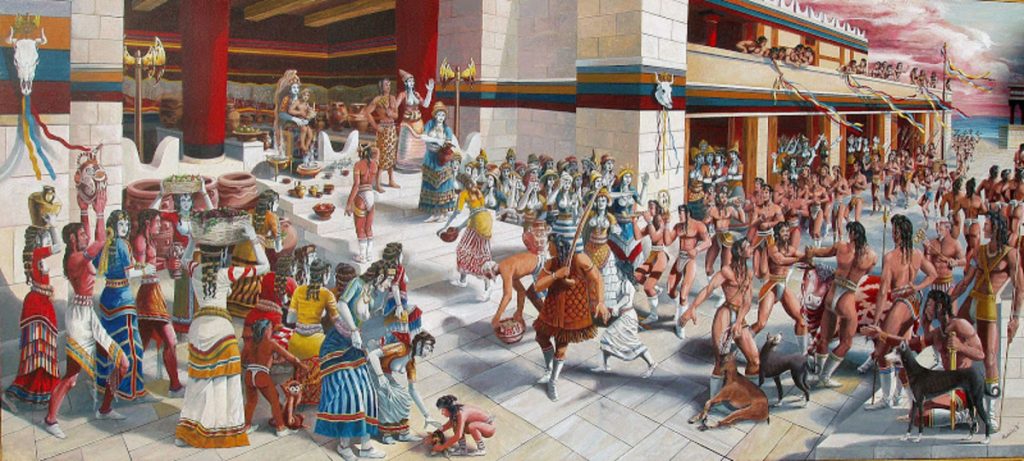
Here’s a nice illustration of the throne room of Nochet. Now obviously this is an adaptation of the Gloranthan original to look more Minoan but the base elements are there. We have the Queen with a child, one of her husband-lovers, a sister-priestess, and another priestess. A young handsome warrior is lower on the steps, perhaps a supplicant, perhaps a representative of a fertility cult like Barntar or Thunderer, or perhaps a bodyguard. A young noblewoman offers gifts, behind her is a line of offerants. To the sides are priestesses and noblewomen.
You can see the throne room is protected by Babeester Gor (see those axes), although I don’t see any of her cultists (but they might be in a different part of the room).
Pretty clearly this is part of a Holy Day ceremony. The Queen spends much of her time in rituals and such ceremonies, which is why many Queens are more ceremonial figures than hands-on rulers (although the last few have been hands-on rulers).
While Nochet is mostly run by Earth priestesses, there are many associated cults represented in the population, including the Husband-Protector cults like Orlanth. We have some numbers on this from a previous Journal: 10k Orlanth initiates! This is the biggest Orlanthi city, bigger than Boldhome! Many of those (and other cult members) are from Sartar, too:
Nochet is a city that plenty of Sartarites have been to. In fact, if the Sartarite community in Nochet was its own tribe, it would be a mid-sized tribe, bigger than the Culbrea!
There are maybe about 9000 Sartarites in total in Nochet. There are about 6500 in Boldhome.
Nochet shows up routinely when you roll the Family History of a RuneQuest character:
Many of your player characters may have spent a year in Nochet during the wars in the Holy Country, especially if they are Sartarite warriors or nobles. They’ve seen the culture and art, enjoyed the food and drink, with its exotic spices and flavours.
Many Sartarite leaders in 1625 spent years in exile in Nochet – for example, Erenava Chan could have been one of the priestesses in that picture! Now they have returned to Sartar, but the richness of Nochet no doubt remains with them.
And of course there are religious, trade, and cultural links between Nochet and Sartar. Probably more than you think.
Vamastal Greyskin’s Tattoos
Jeff, Jaye Kovach, and Anna Orlova have been working on defining the tattoos of many Dragon Pass NPCs (we had Vasana’s tattoos detailed in issue #27).
The idea here is to create a set of references for future art, but also to let people know what the various tattoos mean, and to let those tattoos be a guide to that character’s life experiences.
Obviously some Sartarites will be more covered in markings than other. One of the more extreme characters is Vamastal Greyskin, the current (post-Dragonrise) King of the Sambarri Tribe and City Rex of Wilmskirk. He’s a powerful Orlanth Rex heroquester and one of the more magically powerful people in Sartar.
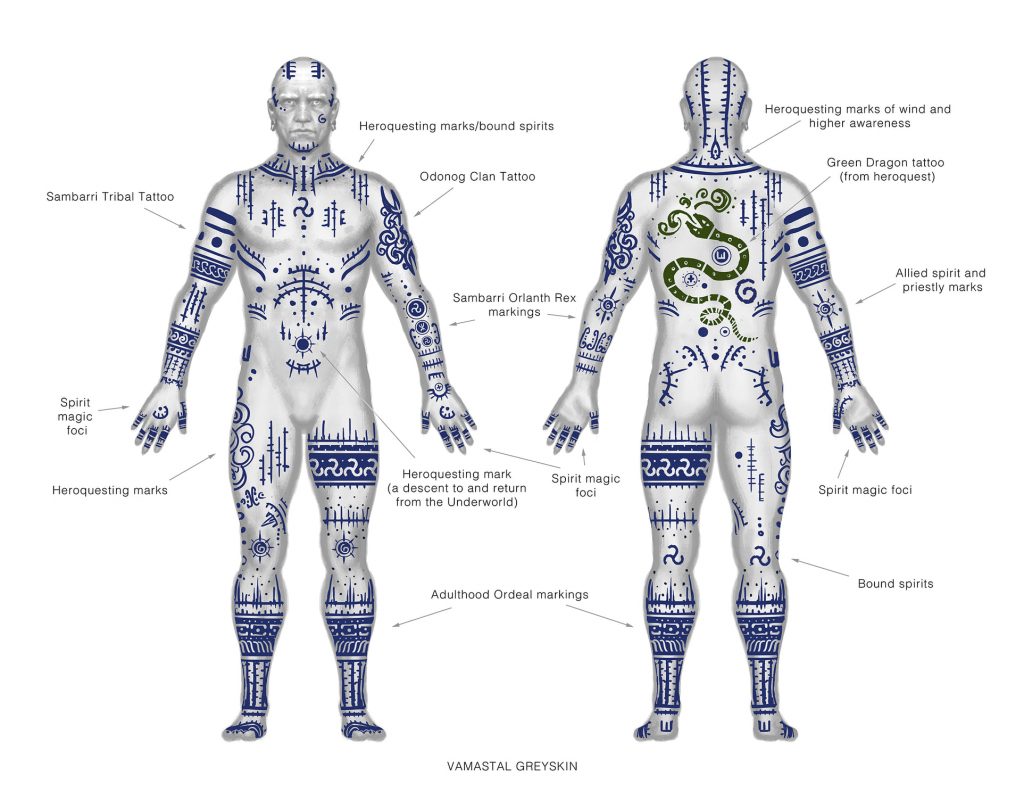
Born in 1574 to the Odonog (Squat Oak) Clan, Vamastal served on the Sartar High Council in 1613 and again in 1625. He was king of Sambarri Tribe until the defeat of Starbrow’s Rebellion. Vamastal gained his ill-colored skin on a failed heroquest attempt many years earlier which, many believe left him more mad than inspired. He has the gift of vision, and prophesized both the battle for the Hill of Orlanth Victorious in 1613 and the Dragonrise that destroyed the New Lunar Temple. One of Argrath’s earliest supporters in Sartar, he pledged loyalty to the White Bull in 1624. After the Dragonrise, which destroyed much of the Sambarri tribal lands, Vamastal was acclaimed tribal king of the Sambarri and was acclaimed City Rex of Wilmskirk by the local assembly.
Major Figures of the Hero Wars
There are a few important NPCs behind the Hero Wars meta-plot, and it looks like Jeff is starting a mini-series on that, so I’m grouping the first few ones here. This post also seems appropriate as an introduction:
The dance of the main characters of the Hero Wars – Argrath, Harrek, Feathered Horse, Jar-eel, and the Red Emperor – is the engine that drives the setting during this period. Your characters can participate in this dance, that’s one of the big advantages of setting the game in 1625.
It is entirely possible that an RQG adventurer from any of the starting Homelands could interact with everyone one of these characters directly in the years between 1625 and 1628. Or not with any of them, depending on the direction your campaign takes.
There’s lots of other heroes active in Dragon Pass at this time. Gunda the Guilty, Jaldon Goldentooth, Beat-Pot Aelwrin, Kallyr Starbrow, Sir Ethilrist, the Inhuman King, Ironhoof, the Dwarf, Keener Than, Lestus Creeping Ivy, Cragspider, Delecti, and many more. Any or even all of these heroes can be woven into your game as rivals, allies, enemies, or mentors.
To me that is the biggest development of RQG – that we finally get to play in the setting that started this all.
As a relative newcomer to RuneQuest and Glorantha, I’m curious about playing in the 1610s and early 1620s because there’s a lot of old material considered to be “classic” (Borderlands, Griffin Mountain, The Red Cow saga, etc) that I’d love to try. I don’t think I’m the only one who has this curiousity, judging from the play reports I see online. But for those that have been playing in 1621 for 30 years, I can totally understand that it’s a relief to see the “official” timeline moving forward:
Actually, I find starting in 1625 much easier than 1621. That way you skip stuff like the Windstop, the war in the Holy Country, and the Dragonrise. You start with a newly liberated Sartar and then build on it.
The Windstop is indeed one of the big gameplay problems of Dragon Pass: your players build up their Orlanthi and Ernaldan characters until, suddenly and out of their control, they can’t use magic anymore. It sort of sucks. Of course, it can also be a very dramatic part of their life: helping your community survive the Windstop can be a powerful arc, and leaving Dragon Pass for Pent, Kralorela, the West, or even Pamaltela can be a thrilling adventure… but I think that’s one of those big things the GM might want to talk to the player about.
From Dragonrise to the Battle of the Queens you mainly are dealing with one Second Tier Hero (Kallyr), the First Tier Heroes are present at the side of the board, although you might get a guest appearance from a First Tier Hero (Jar-eel). You get to see how the Principality functions, and then get to watch as it nearly falls apart. Basically you get a full year before the First Tier Heroes all start showing up.
I’m sure Kallyr would NOT appreciate being called a Second Tier Hero, so make sure she’s not within earshot when you say that…
All five of our major figures are complex heroes, with a variety of backgrounds, cults, and experiences. They also range quite a bit in age, so in 1625:
Feathered Horse Queen is 20(!) years old
Argrath is 29.
Jar-eel is 37 (but looks 22).
Harrek is subjectively 45, but really 140.
Red Emperor is who knows how old. The current Mask has ruled for 18 years. But there has been a Red Emperor for 375 years.
Now I know that meta-plots have been a hot-topic in TTRPG circles since at least the White Wolf era of Vampire: The Masquerade (if not earlier, with Traveller and such). But where some people see (and complain about) a supposedly “rigid meta-plot”, I see more a sandbox of faction gameplay, with various major NPCs leading various sized groups for whatever agenda they have. The more moving pieces, the better.
This is why I’d love to see more material about (and play more with) some of those NPCs and factions that don’t get as much spotlight: Ethilrist, the Inhuman King, Brangbane, Delecti, any dwarves, and, above all, Cragspider! Love love love Cragspider.
I also often think about historical settings. If meta-plots were so bad, would it mean we couldn’t play games in, say, World War II or in Middle Earth? That’s preposterous.
Anyway, on to the major NPCs!
Argrath
He’s one of the main guys, so better get to know him:
At a very fundamental level, Greg’s Argrath IS Arkat and fully experiences and participates Orlanth myths as a mortal. Now that doesn’t mean that he is trying to repeat the deeds of Arkat or Orlanth – in fact, very much not trying to repeat their deeds. Rather he is confronting new situations as if he was Arkat or Orlanth, if that makes any sense. Not only does he accept he will do something new, he intends to do something new! This makes Argrath more in tune with Orlanth than most any other Orlanthi hero, Harmast Barefoot included.
That is likely the secret to his success. Argrath discovered that not only is repetition of the myth unnecessary, but it is often undesirable. What matters is the participation with the raw powers and archetypes of the world, and a willingness to cause change in order to preserve the cosmos.
In other words (and as far as I understand), there’s no point in redoing the myths of Orlanth wooing Ernalda, killing Yelm and the then saving Yelm, and so on. The point is to get some girls, fuck shit up, own up to your mistakes, and keep going. These are the raw archetypes, and they’re more powerful than the re-enactments.

It is worthwhile to look how much Argrath’s life experiences parallel those of Orlanth. Exile to the Strange Gods of the Wastelands. Communication with spirits and dragons. Marriage and kingship. And so on. His life parallels that of his god. No wonder that the post-Hero Wars cultures often viewed them as the same entity!
Indeed, Argrath is “exiled to the Strange Gods of the Wastelands” by, well, being literally exiled to the Wastelands shortly after his adulthood ceremony: he had to flee Sartar after killing some Lunars, and was taken as a slave by the Bison Tribe. And thanks to Brian McReynolds for pointing out the connection Orlanth here, which is found in King of Sartar: Orlanth and his brothers were “initiated” when some giants came and threw them into all kinds of annoying situations: Humakt was thrown into a Fighting Pit, Vadrus was cast into a Deep Well, Storm Bull was thrown into the Animal Corral, and so on.
Orlanth was put among the Strange Gods, which the giants thought would destroy Orlanth. But although Orlanth did quarrel with them at first (we wouldn’t expect anything less from him), he then made friends with some of them and came back. And that’s pretty much what Argrath did in Prax.
This is also tied with the idea that Argrath=Arkat. Like Arkat, Argrath fought Gbaji and was transformed in the process. In the end, the Red Moon was broken and the world changed. Like Arkat, Argrath embraced monsters to carry forth his task – Arkat with trolls, Argrath with dragons. And like Arkat, it is possible to view Argrath as purifying the Moon Goddess, removing its Chaos taint so that Glorantha’s cycles might no longer threaten existence but become fully a part of it.
At a very basic level Argrath and Arkat were the SAME ENTITY. In Greg’s earliest stories, a hero named Argat (Aragat, etc.) fought against Gbaji to end the age of legends and begin history. This character was then put into White Bear and Red Moon by Greg as Argrath, the Prince of Sartar. Later he was put into Gloranthan history as Arkat Chaosbane. But ultimately they had the same source.
Jeff’s favourite depiction of Argrath is this bonkers Moebius-esque illustration from the Nomad Gods board-games, later re-used in the RuneQuest Companion supplement:

Here are a few more comments to get deeper into Argrath’s vibe:
Now to the Arkat-orlanth mix, I add for my own understanding Alexander and Bowie. He’s the romantic adventuring hero, the magical rock star who reinvents himself whenever you think you got him figured out.
Arkat was a rational materialist who needed to embrace his irrational monster in order to confront Gbaji. Argrath was a exiled outsider who needed to find his community to confront Gbaji. To overcome the Deceiver, we need to confront and deal with our own Shadow.
Lord knows Greg and I talked enough about Argrat-Arkat-Argrath-Arthur-Alexander.
Jar-eel
Let’s look at the Lunar bad-ass demi-goddess Jar-eel:
The Fourth Inspiration of Moonson, Incarnation of the Red Goddess in Time, daughter/lover/mother of the Red Emperor, poetess and musician, defeater of barbarians, etc. Jar-eel is the great-granddaughter of the demigoddess Hon-eel the Artess and the defender of Lunar civilization and enlightenment.
Blessed with grace, intelligence, and beauty, she has already become an immortal. She is a living goddess, seemingly flawless, merciful and cruel, with an enigmatic smile like the moon. The perfect face of Lunar civilization, she inspires lust and love with all who see her, and yet kills without hesitation or remorse.
Jar-eel has proven herself as a peerless fighter, magician, poet, musician, and Heroquester. She has stormed impregnable citadels, transformed rebels into followers, dismembered an enemy demigod, debated gods in contests where her soul was at stake, given rightful order to Chaos, and emerged triumphant from the Pit of Sorrows as the Balancer and Turner. She saves Beat-Pot Aelwrin and he becomes her most devoted servant and one her lovers.
Remember that Jar-eel was born around 1588, so when she led the Imperial Bodyguard victoriously up the cliff-face of Boldhome’s Royal Palace, she was 14 years old.
It is worth keeping in mind that Jar-eel and Argrath are each other’s shadow self. Argrath is the rebel, the romantic adventuring hero, the magical rock star who reinvents himself whenever you think you got him figured out. Jar-eel on the contrary is a goddess of the Empire. Her attributes are not only love, beauty, sex, war, and justice (and do not forget how important her sense of justice), but also political power. She moves on from conquest to conquest like Inanna. Although she is a goddess of love, beauty, and sex, she is not associated with marriage and is not associated with grains, general fertility, etc. She has one child as far as we know and that is not a key part of her identity as a living goddess. A living goddess of love and war.
The reference to Inanna here points to the real-world Mesopotamian goddess, famous for going into the underworld and coming back out. It’s a wild story: she wants to conquer her sister’s realm down there, but messes up and is struck dead! When her people come and save her, she gets her husband to die and take her place! Just because he didn’t mourn her death well enough or something. Later, Innana sorts of feels bad about it, so the husband is permitted to come back up to the surface half the year, but then Innana’s sister has to take his place during that time! Way to go Innana, you’re a stone cold bad-ass manipulator. Anyway, this switching of places starts the cycle of seasons.
In terms of a real world point of reference, I’d look at Inanna and her various echoes. Here’s a great hymn to Inanna that works great for Jar-eel:
“She stirs confusion and chaos against those who are disobedient to her, speeding carnage and inciting the devastating flood, clothed in terrifying radiance. It is her game to speed conflict and battle, untiring, strapping on her sandals.”
And of course, when we think of our goddess of love and war riding atop the Crimson Bat, we can’t help but think of Revelations – “I saw a woman sit upon a scarlet coloured beast, full of names of blasphemy…” And that of course is Jar-eel as well – the Mother of Abominations, the Scarlet Woman, and of course Babalon.

Yep, this is indeed conjuring vibes of the Whore of Babylon, the “Harlot Seated on the Beast”, which happens to be all red and very dangerous, if that rings a bell. Jeff follows that thread all the way into the esoteric Thelemic bullshit of Aleister Crowley with Babalon. Aleister Crowley is an asshole but he has all the good stuff. And although Crowley wasn’t directly involved, check out the Babalon Working, an attempt to summon Babalon with ceremonial and sex magic by Jack Parsons (a founding member of the JPL… yes, that JPL) and Ron Hubbard (yes, that Ron Hubbard).
There definitely were Inanna-Babalon-Whore of Babylon themes going on with Jar-eel. Remember at the time Greg was publishing Bonewits, and Babalon riding the Beast was a common motif in the SF Bay counterculture of the 60s and 70s. Heck I can remember psychedelic posters with that theme in Berkeley bookstores as a kid in the late 70s/early 80s.
And when you imagine Jar-eel riding the Crimson (Scarlet) Bat with its many tongues and eyes, the imagery becomes unescapable.
Back to Glorantha:
If we look at the relationship between Jar-eel and Beatpot, we easily get Inanna and Dumazi. Beatpot is her lover, her cook, and her priest – but Jar-eel has all the agency. She takes other lovers – that is her prerogative as a living goddess of love and war. If Jar-eel gets killed, he’d better mourn her, or he’s going to be in a world of hurt when she gets out of the Underworld!
Dumazi here is Dumuzid, Inanna’s husband who ends up going into the land of the dead in her place. She has been gaslighting him for so long that he’s ready to die for her, and Beat-pot is the same with Jar-eel. There’s more about Beat-pot after this section on Jar-eel, because he’s a whole thing too.
Jar-eel is also the dominant personality in the Lunar Empire of the 8th Wane. She overshadows “her father” the Red Emperor and everyone else. She walks into the court, and all eyes are on her. Jar-eel is what most people see when they imagine the Red Goddess.
Justice is also a key attribute to Jar-eel. But it is not Justice as we moderns might think of it. It is the justice of Natha – retribution against those deserving of it, and protection for those deserving of it. It is beyond law, moderation, or social agreement – it is divine and terrifying in expression.
Natha is… hard to pinpoint. She’s the Goddess of the Second Underworld, Keeper of the Second Hell. She is the Lunar Goddess of Balance, the Avenging Destroyer, and one of the seven ancient Moon Goddesses. She is the Goddes of the Empty Half. She gives life or death, light or darkness, sour candy or kale salad, and so on based on what is needed to bring “balance” in the world. I get the feeling that she doesn’t do “Justice” as much as she does “What’s Needed” (for a certain cosmisc definition of “need”).
She is Nemesis to those who harms the Lunar Empire. Implacable justice against those who would harm or threaten the followers of the Red Moon.
This Nemesis function is where her Cruel/Merciful contradiction comes in. To those who have harmed the Lunar Empire (a very fuzzy definition), she is a terrible goddess of vengeance. But to those who need its protection, she is benevolent, kind, and loving.
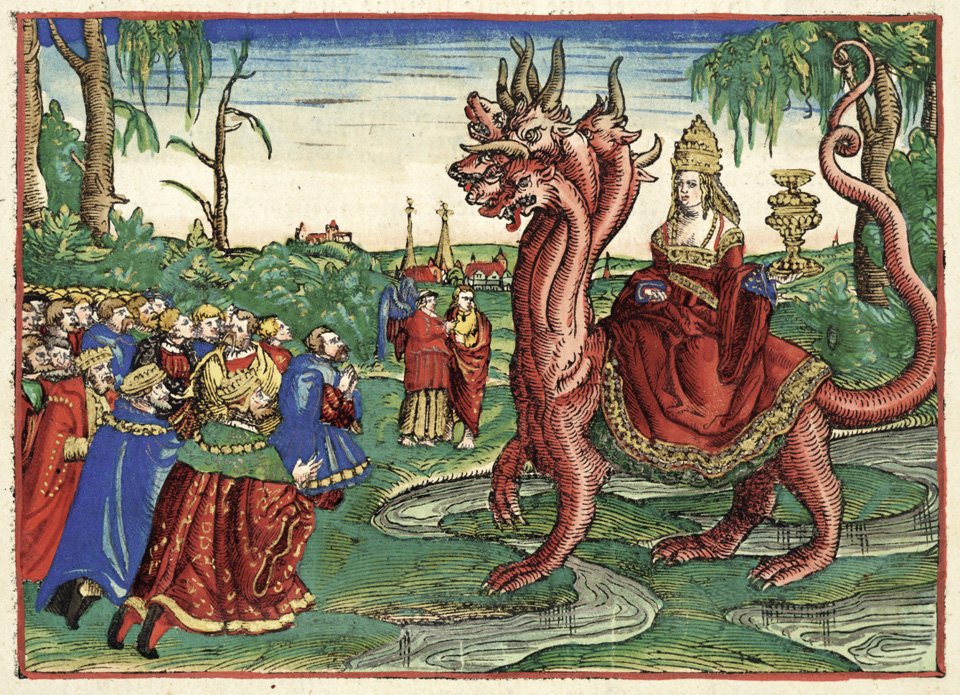
To her foes, Jar-eel is the Whore of Glamour, who rides a Scarlet Abomination. She consorts with broo, vampires, and other monstrosities. To them, Jar-eel is a personification of the Lunar Empire and of Evil itself.
I cannot think of a more divisive figure in Glorantha than Jar-eel, maybe only Arkat rivals her. She is a living goddess within the Empire, a personification of evil outside of it. Even Argrath doesn’t engender that much hate – to most Lunars, he is “just” a barbarian rebel and not even the most frightening. But in the Provinces and beyond, Jar-eel is the personification of the Red Goddess and Her Empire.
One of Jar-eel’s most famous fucked-up things (almost literally in this case) is the “spiritual liberation” of King Moirades of Tarsh, also known as “having sex with Jar-eel”.
The currently known list of lovers (as of 1625) includes Beat-Pot, Moirades, at least one Mask (probably two), no doubt a god or three, no doubt satraps, yoga instructors, and many others. Moirades died at his moment of enlightenment, and no doubt there are tantric depictions of Jar-eel standing atop a prone but blissful Moirades, like Kali atop Shiva.
Yep:
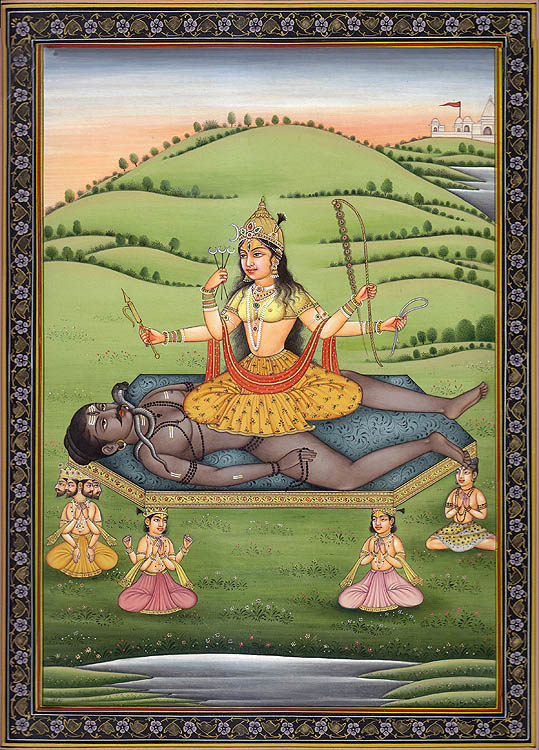
Beat-pot Aelwrin
As promised, let’s look at Beat-pot next:
Aelwrin was born in 1592 amongst the Pentan nomads in the Redlands, and enslaved as a child when his tribe revolted against the Lunar Empire. He was made a kitchen slave, showing little talent for anything else. In 7/42 (1613), Beat-Pot organized and led a successful slave revolt, earning his name by using only the tools of his trade as weapons. Jar-eel repressed the slave revolt, but took it on herself to teach the Lunar Way to Beat-Pot. Now the high priest of the Moonsword cult, he is inseparable from the cult goddess: Jar-eel.
Beat-Pot is a strange one. A warrior, former slave, and bad man (a little of that Danfive Xaron role – and in truth, DX is based on Beat-Pot and not the other way around), he is also an agricultural-fertility figure (and one heck of a cook) in the Lunar Empire.
The Danfive Xaron sub-cult of the Seven Mothers is that of penance and repentance for those who seek redemption in the eyes of the Red Goddess… but Beat-pot took a slightly different route:
Beat-Pot Aelwrin is often identified with Danfive Xaron although he is not a member of that cult. Beat-Pot exemplifies the ability of the Red Goddess to purify even the most desperate criminal and bring them back into the community of gods and men. As a result, Beat-Pot is widely believed to be an incarnation Danfive Xaron and he is known to favor members of the cult. Once a year, Beat-Pot prepares an exquisite communal meal for members of the cult, to remind them of the beauty that exists even within the stringent strictures of Danfive Xaron.
[…] Beat-Pot is DX without the punishment, purity, or self-repression. His way is arguably even more extreme, but it is also definitely more fun.
There’s still more about Beat-pot:
One way of thinking about Aelwrin is that he is Dumuzi to Jar-eel’s Inanna. He is Jar-eel’s lover, priest, and servant – and is the advance man for his Goddess. As the right-hand of Jar-eel the Razoress, even the mightiest of satraps and generals are wary around Aelwrin.
However, Beat-Pot is also Jar-eel’s head chef, a noted gourmand, and thus the Lunar Empire’s version of Marcus Apicius or Lynceus of Samos or Taillevent. We know his diaries from his time as a kitchen slave for the Imperial Bodyguard – they are the height of popularity among the highly literate Lunar ruling class. It is compliment to the Empire that they allowed the famous “Aelwrin’s Complaint: the Slave Spitting on his Master” to be published in a cookbook. Beat-pot’s popular recipes included the ever-popular spicy liver-loaf, kidneys in fermented milk, and broiled walktapus tentacle fillet in a brown sugar glaze.
He is the Lunar’s Empire version of who what who? Ok, here are some quick search results.
Marvus Apicius was a Roman gourmet from the first century CE (under the second Roman Emperor, Tiberius). He is believed to be the author of the Roman cookbook Apicius:
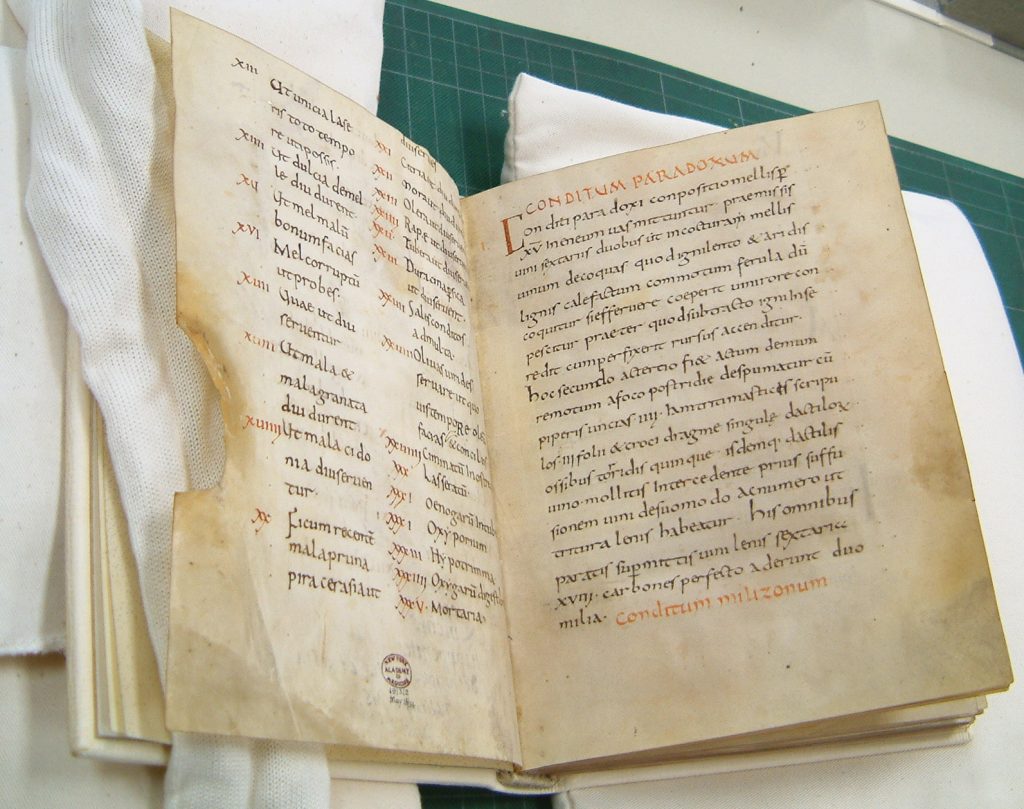
Lynceus of Samos was another gastronome, but from the earlier times of Ancient Greece, around 300 BCE. Besides essays on food, he also wrote some comedies and humourous stories.
Guillaume Tirel, aka Taillevent, brings us to 14th century France, where he was a cook to nobles, kings, and queens. He wrote many recipe manuals, and some restaurants are named after him to this day.
Jeff also mentioned that he sees Beat-pot at the “Anthony Bourdain of Glorantha”.
Beat-pot even has some explicit instructions, from his early diaries, for preparing and cooking a Walktapus. The full instructions are in Wyrms Footnotes #2.
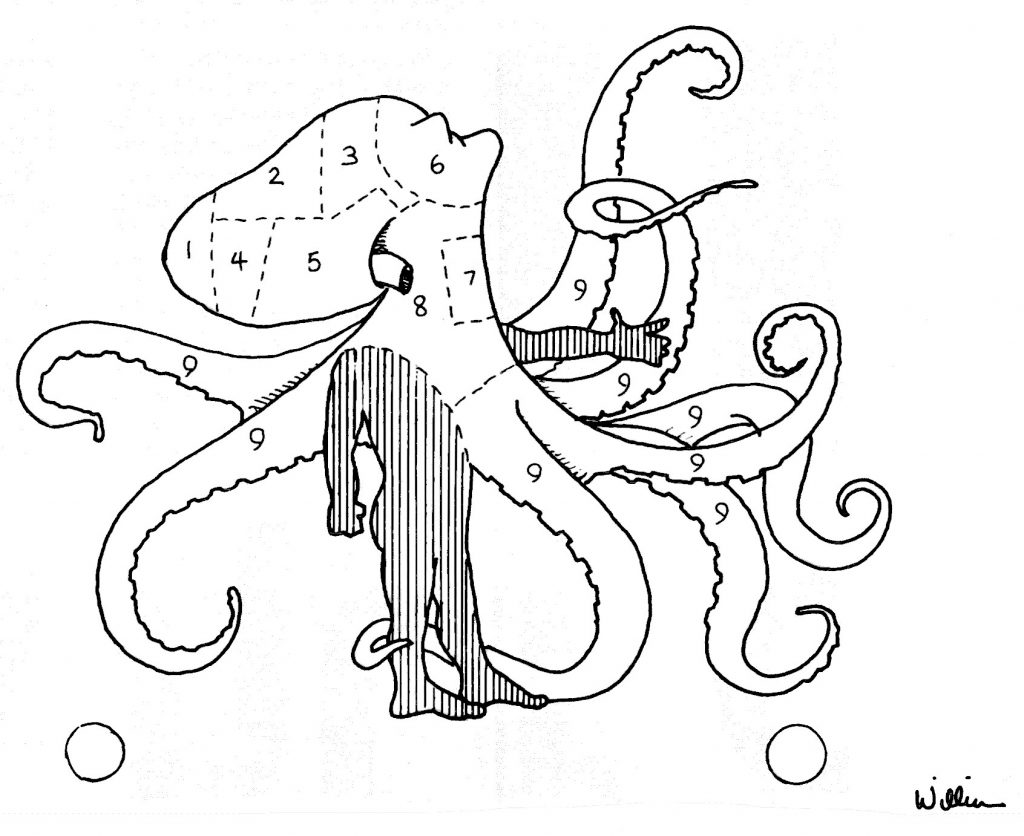
[Beat-pot] is recorded for having a great deal of bitterness towards how he was treated as a kitchen slave, and although he is completely devoted to the Red Goddess (through Jar-eel), he has notable contempt and righteous disdain for much of the Lunar elite and nobility. As the right-hand of Jar-eel the Razoress, much of that Lunar elite and nobility tries to curry favor with Beat-Pot, which just reinforces his contempt and disdain for them.
Remember that Beat-Pot has been active in Lunar affairs for some dozen years. He is admired by the peasantry and the common folk (if feared by them), and his recipes and diaries are collected by the literati. He is more a gourmet than a gourmand – he is said to eat sparingly, but very knowingly.
That being said he cares not about the status of a particular meal – merely its taste and skill in preparation. I once heard that he proclaimed the maize bread from a Furthest food stall better than that prepared by Hon-eel’s priests in Glamour.
Earlier, Jeff mentioned that Beat-pot was a “bad man”. This isn’t just in the eyes of the Lunar Empire (because he tried to rebel) but also because he pillaged, raped, and murdered:
Prior to accepting the Lunar Way and devoting himself to Jar-eel, he led a violent slave rebellion against the Lunar Empire. He committed many a crime in the process – and not just the crime of rebellion.
Beat-Pot was a bad man; he is now a good man. He is at peace with himself and the cosmos. He has forgiven himself for the crimes of his past, and now he works to further the community of gods and men. I don’t pity him – I envy him!
Beat-Pot holds out hope for all of us that have done things which we regret that it is possible to be forgiven for those things – and to return to community of people and gods in good faith and conscience.
Ironically, I am not sure that Jar-eel or the Red Goddess had the same blessing.
Ironhoof
Next up is the Lord of Beast Valley:
The son of Orlanth and the horse goddess, this demigod ruler of the Beast Men has reincarnated several times throughout – and even before – history, most recently in 1615. He adopted the Grazeland Pony Breeders and was the first sacred King of Dragon Pass. Ironhoof is a centaur and lord of all horses.
Ironhoof is a liminal being: half-man, half-horse; half-god, half mortal. He is caught between the two natures he embodies – both an embodiment of untamed nature and a wise teacher and just ruler.
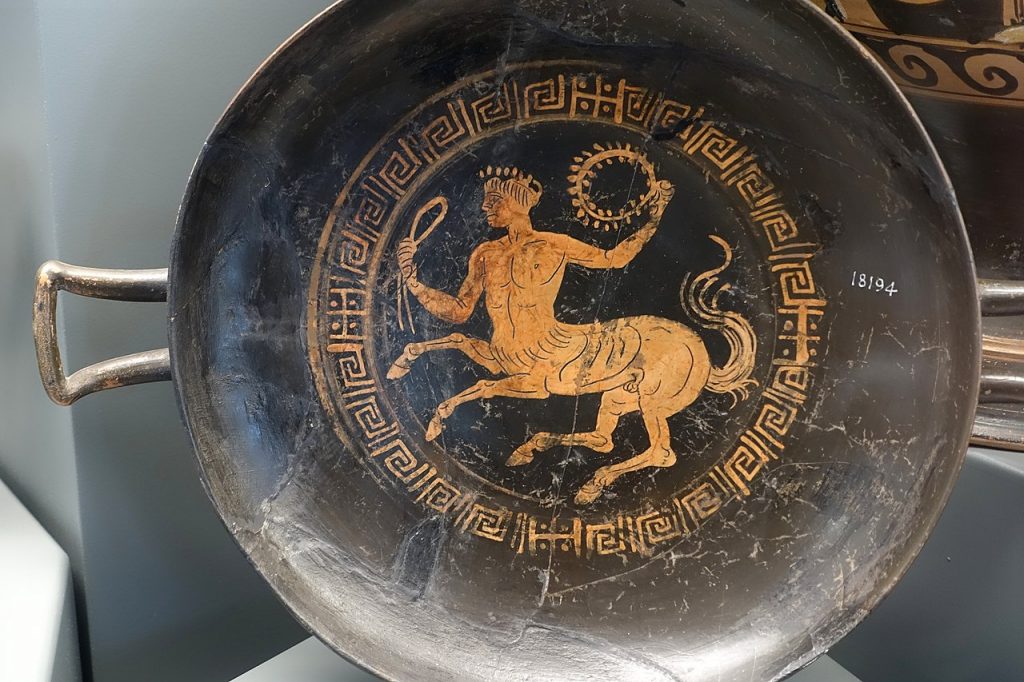
I’ve heard stories that Ironhoof’s spirit resides at the Wild Temple and takes corporeal form when summoned by the Beast Men.
You can see more about the Wild Temple, and Ironhoof, in The Smoking Ruin & Other Stories scenario collection.
The Beast Men, when led by Ironhoof,, bore great friendship for the Grazelanders, always sided with them during the first wars after humans had resettled the Pass. As politics became more complicated (particularly after 1380), Ironhoof became more reserved, and often commanded his subjects to avoid all human contact. Even the Grazelanders became suspect after a time.
The reason things started getting more tense after 1380 is because the Lismelder and Colymar tribes, who only resettled in Dragon Pass a couple generation prior, tried to seize the farmlands of the Beastfolkf in the Duck Valley.
When the Hero Wars period began, the general increase of magical energies attracted the Beast Men from their lairs, and they could often be seen marching or scouting for either of the major combatants. Mercenary regiments of half-men were often hired, while Ironhoof himself would lead his armies in person when their interests were involved.
In other words: add some group of Beastfolk mercenaries and travellers here and there in your campaigns!
The “re-emergence” of the Beast Men as a significant faction in Dragon Pass was likely a response to the major release of magical energies in the Hero Wars era. Previously, humans just generally avoided going through Beast Valley, and the Beast Men, for the most part, stayed put. Sure wandering satyrs and centaurs might be seen in Sartar or Sun County, but they were no more notable than the occasion elf or troll.
But in the Hero Wars, Beast Men mercenaries became a common sight. Most were mere mobs of beasts – minotaurs, manticores, and other half-men hybrids. But some were bands of centaur skirmishers and archers.
The Orlanthi of Maniria
We know that the Orlanthi culture is spread all around Genertela: not only in Sartar but also in some of the Lunar Provinces, in the Holy Country, and, among yet other places, to the west of the Holy Country, where Maniria is. Here’s an AAA map to locate this:
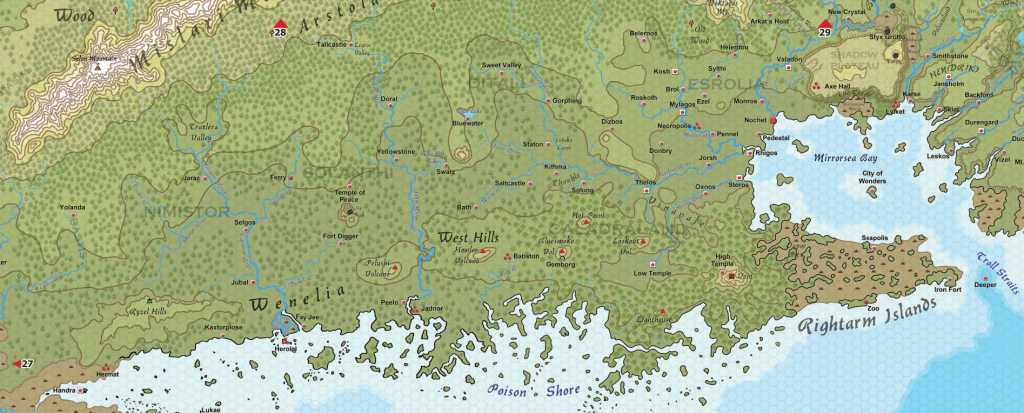
To the west of Esrolia are four Orlanthi tribal confederations. The first – Longsi Land has long been under the suzerainty of the Esrolian Queens. In older texts this was called Haradlaro or the Harandings. Some scholars speculate that this was the homeland of the great Orlanthi hero Aram ya-Udram. It is now a semi-autonomous part of Esrolia.
Longsi Land isn’t located on the AAA map, but you can find it around the city of Kosh, between Belernos and Roskoth, in north-western Esrolia. You can find it more easily in this archive map below that Jeff generously shared:

The people of Longsi Land sided with Esrolia in the 12th century when Esrolia and Hendrikiland were at war. I didn’t look too much into this but basically they were granted the city of Kosh for their support.
Aram ya-Udram is an interesting figure, though. He was already a hero at the Dawn, having “captured a great Darkness spirit”, and was part of the Unity Council. His people, the Aramites, angered the Earth goddesses somehow and Gouger the giant boar was sent after them. Aram ya-Udram tricked it, killed it, and built the Ivory Plinth there with one of its giant tusks. But the Aramites didn’t really fare well anyway… it’s unclear what happened to them, but the fact is that the Tusk Riders call the Ivory Plinth home, and worship a trio of deities that include Aram ya-Udram, a Darkness spirit, and the god-pig Gouger. It can’t be a coincidence…
Further west are the Ditali, who have caused so much trouble for Esrolia in the decade. At the Dawn, the Vathmai came from this area. Although most of the population are Orlanthi clans, the Ditali confederation was traditionally an alliance held together by Trader Princes. However, in the last decade they have cooperated with the Solanthi in raids and invasions of the former Holy Country.
Still further west are the Solanthi. Although once allied to the Trader Princes, for the past generation this confederation has been held together by the household of Greymane, an Orlanthi warlord. The Solanthi and Ditali raided Esrolia for the last decade, then allied with the Esrolians against the Lunar Empire, only to betray the Esrolians at the Battle of Pennel Ford. The confederation is now in disarray after that battle.
Still further west is the Nimistor confederation. These Orlanthi are allied with the Trader Princes, although those alliances have been fraying in the last generation as the Trader Princes have lost much wealth with the Opening.
The Trader Princes traditionally had alliances with otherwise autonomous Orlanthi clans and tribes – that’s the various confederations, each centered on a river network for trade. They are “Princes” in that they are not kings or tribal leaders, but First among equals.
That system has been falling apart since the Opening. The Ditali Trader Princes have had to take a more active military role to survive, the Solanthi Trader Princes now must defer to the house of Greymane and his heirs.
Community Roundup
The community roundup is our highlight of interesting things being mentioned in the Glorantha-related Facebook groups, sub-Reddits, and other similar online places.
French Dundealos Territory Map
The maps from the French edition of RuneQuest Glorantha (see my article here) have been posted on Thomay Rey’s portfolio so it must be OK to share here! Check out these maps of the Ernaldori clan, and of the Dundealos tribe territory (you can click on them for the higher resolution version):


There are also two new maps showing the former clans of the Dundealos, and the clans of the Enstalos who replaced them when the Lunar seized the lands:
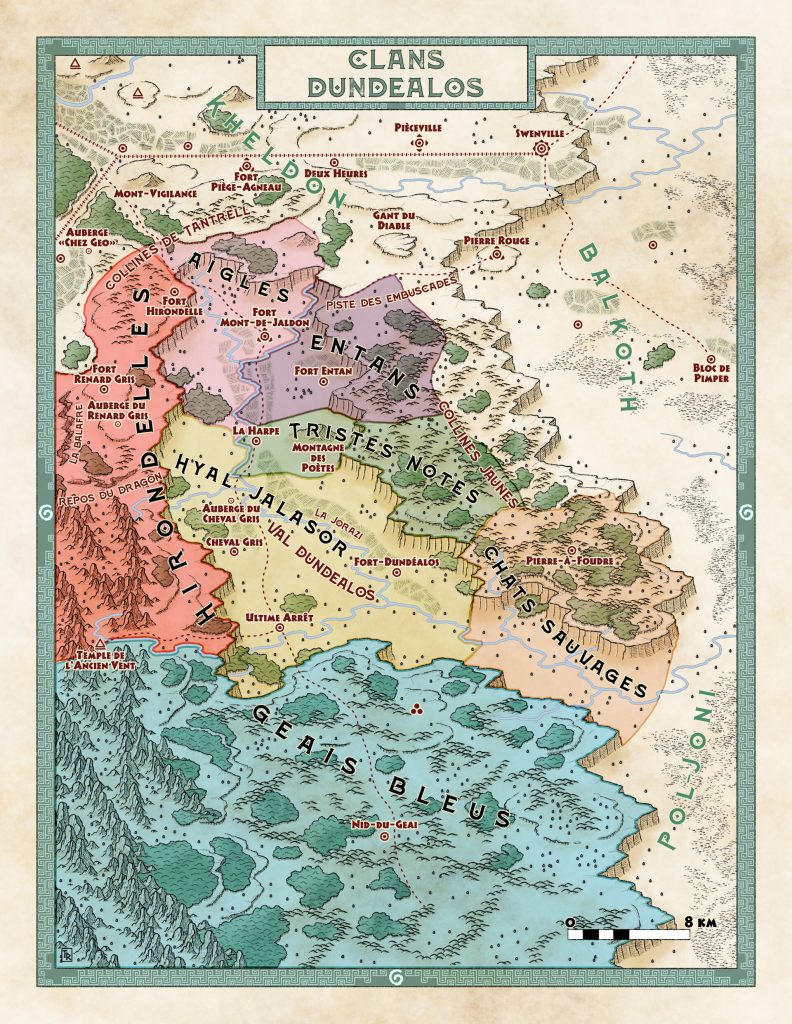
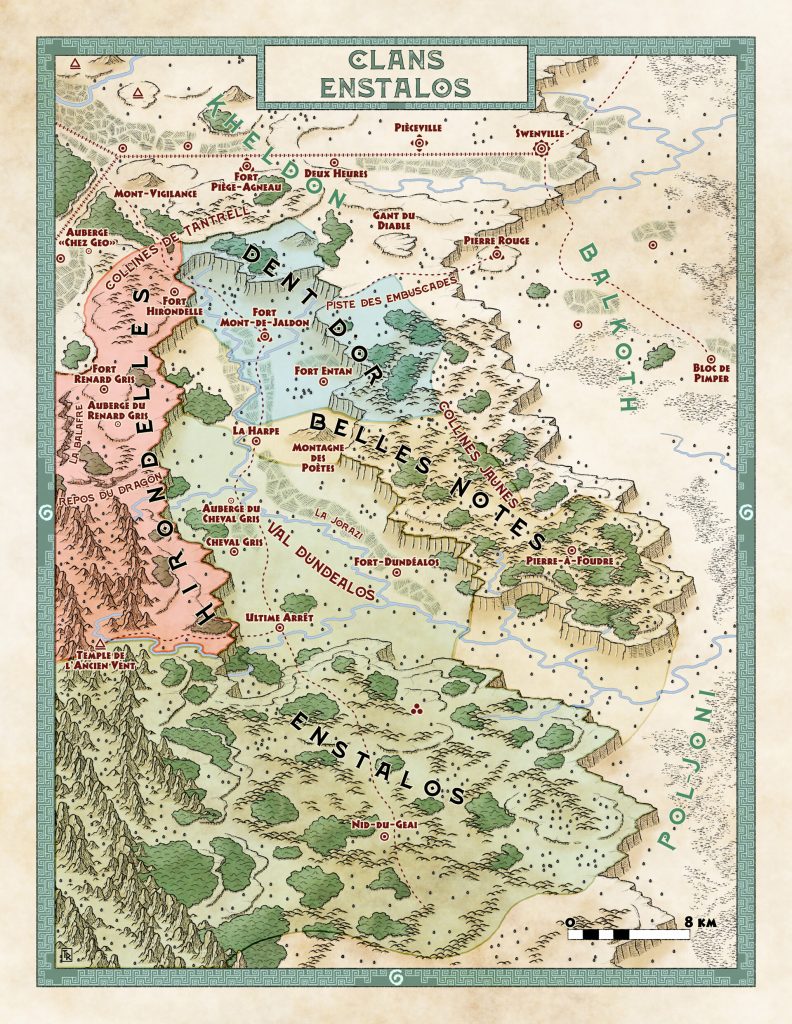
Thanks to 7Tigers who spotted this!
Collection of Glorantha Shields
Here is a very pretty collection of shields by Katrin Dirim:
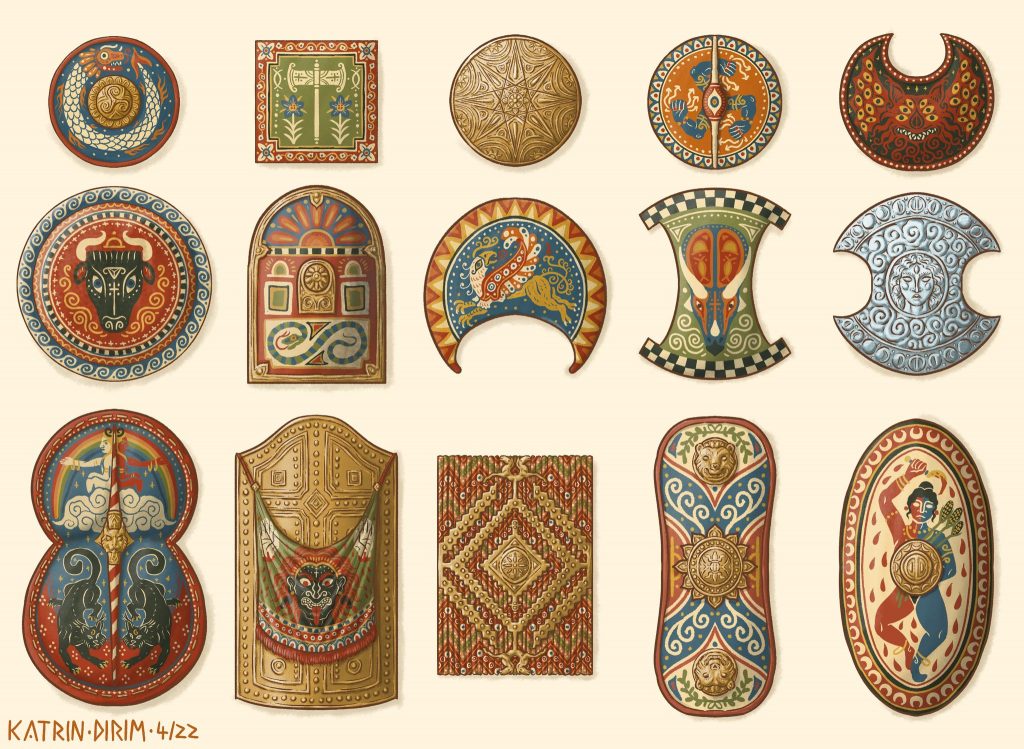
From left to right they are Sartarite, Esrolian, Grazelander, Old Tarshite, and Lunar Tarshite
I love Katrin’s attention to detail.
Esrolian Trireme
And now, an “Esrolian trireme with figurehead and boarding gangways” by Martin Helsdon!
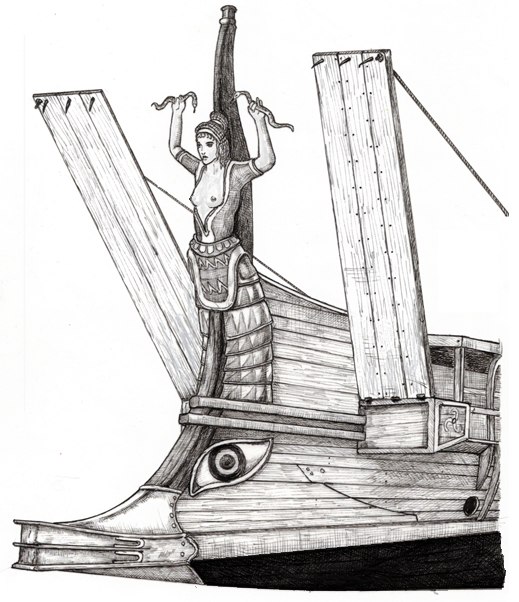
Dario’s Trolls
Dario Corallo also posted some trolls lately! Pikat Yaraboom (a powerful shaman Hell Lord of Dragon Pass) and a Kargg’s Son (I think Dario meant “Karrg”? One of the Seven Sacred Ancestors of the trolls?). Thanks to Mirza on Discord for reminding me that “Kargg’s Son” is the title for Rune Lords of Kyger Litor.
Troll Sage?

Juan Ochoa has this fun doodle of what looks like a troll sage, possibly dual-initiated with Argan Argar. There’s even a timelapse here.
Exploring Glorantha Episode 17: Ducks!!!
JM and Evans talk about ducks! Do you need to hear anything else to check this video out?
Runeblogger Reviews the Equipment Guide
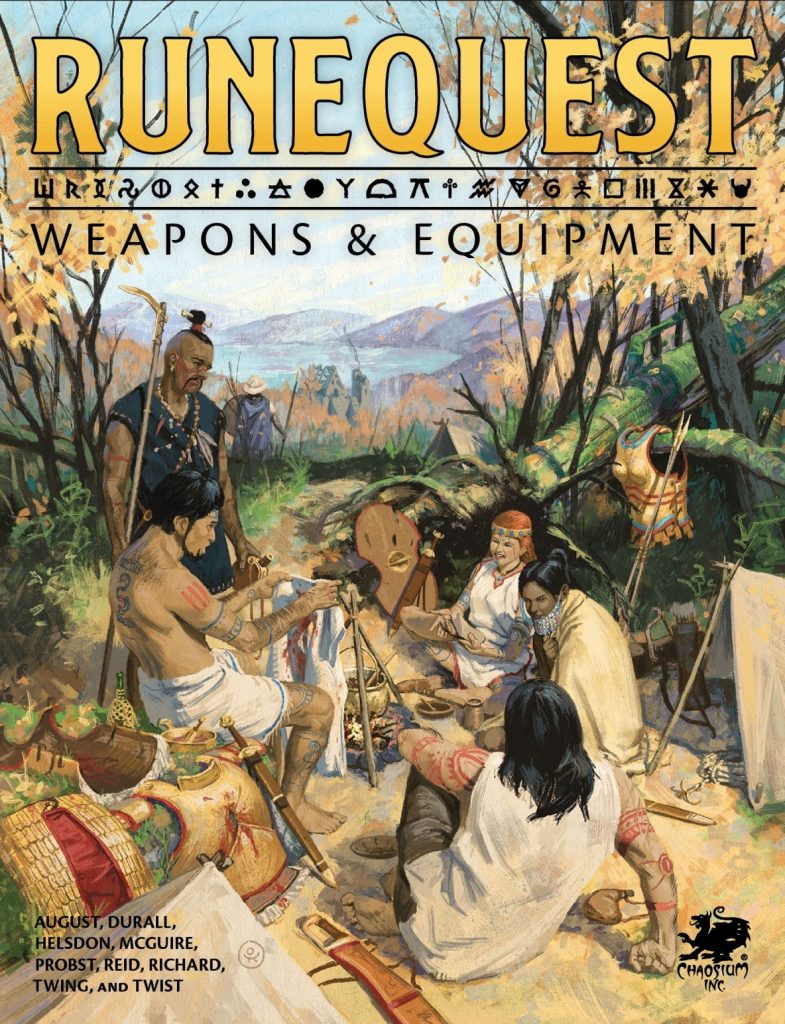
Runeblogger has posted a review of the RuneQuest Weapons & Equipement Guide.
All in all, this book is a must for any RuneQuest player or GM. On the one hand, it is “just” an expanded equipment list, but on the other is much more than that, as it also provides some extra rules that may be helpful, like the ones for managing your hides of land. I particularly like the dwellings and exotic items sections, but there are useful bits and pieces throughout the book, like the full helmet penalties, the price for enchantments, the types of arrows, land events, etc, all accompanied by wonderful art. On top of that, it also helps portray the Bronze Age feel of Glorantha through the depicted technology and the descriptions included.
Harrek Miniature
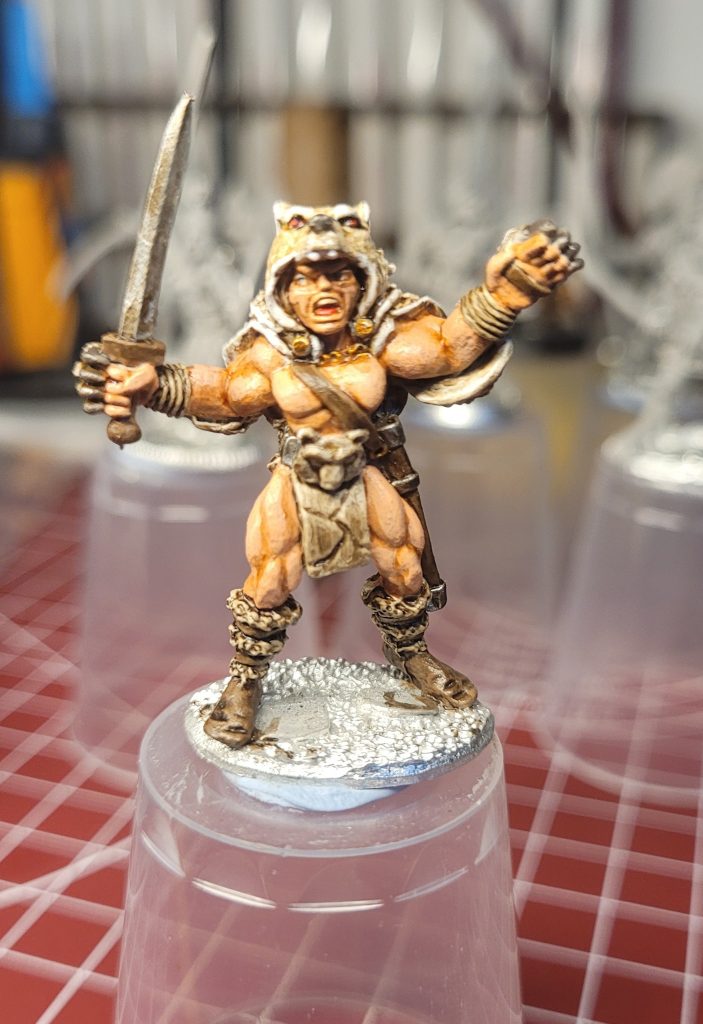
Mat Unsworth shared this painted miniature of Harrek! This is a 28mm mini from Lance & Laser.
Elsewhere on Arachne Solara’s Web
Not everything is about Glorantha, although most things are! Here are loosely relevant things that we found on the interwebs.
Preclassic Maya Caches in Residential Contexts
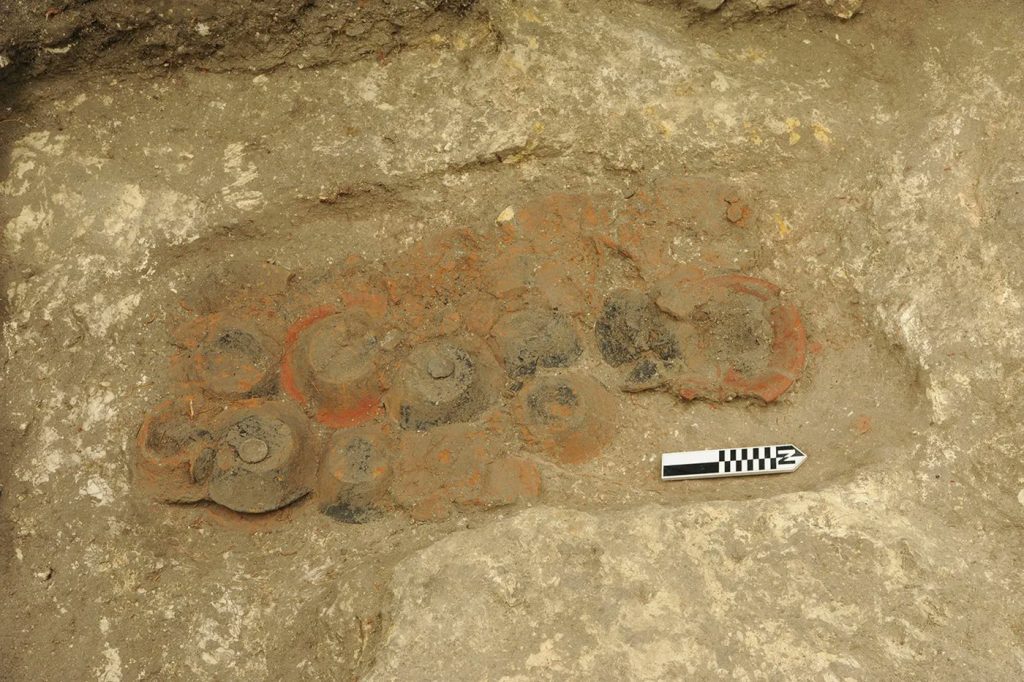
It looks like the Mayans routinely buried things under buildings in construction or renovation, as part of private rituals and traditions. The picture above is a 2000-year-old example from the Maya city of Ceibal in Guatemala, found in front of a domestic shrine.
It’s possible people in Glorantha do the same, with sacrifices to household deities and spirits, or charms for good fortune and health… but maybe also sometimes there’s something in there that doesn’t belong, placed by an enemy who wants to bring harm to your household, or placed by some Chaos worshipper in your building. What kind of adventure is going to start with a discovery like that?
More about the Maya tradition here.
Ladies in Blue and Minoan Procession
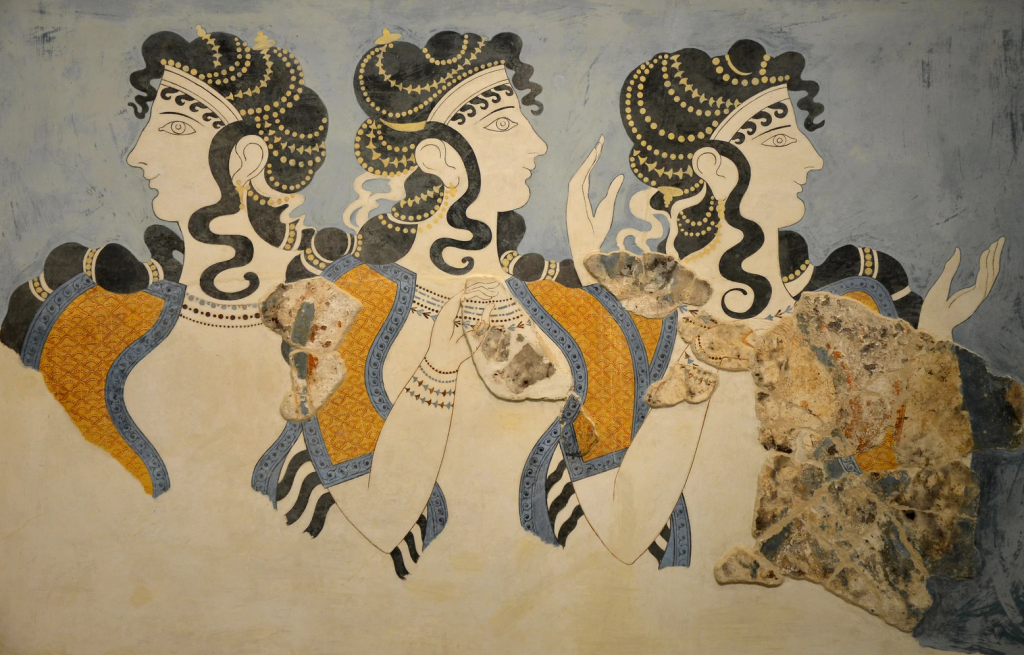
We were talking earlier about the Minoans, so take a look at this fresco is from the Palace of Knossos (in Crete), dated around 1500 BCE. Actually the picture is of a recreation of this fresco, done by Emile Gillieron in the early 20th century. As previously mentioned, Minoan hairstyles and dresses can be used for most Esrolian ladies, especially the Earth-cultists.
More here.
Another thing from the Palace of Knossos is this religious procession:

Take a peek at the instruments being played, the gifts being brought, and the religious artifacts being carried… now have your players go find one of them that’s missing, or bring one on behalf of their leader, or something!
Sarcophaguses of the Ayaa Necropolis
Located in Sidon, in modern day Lebanon, the Ayaa necropolis was discovered in the late 19th century. This read like a Call of Cthulhu scenario, with local workers stumbling upon the hypogea (my new English word of the day, which is a fancy way of saying “underground temple”). There’s even a bunch of awesome handouts for your players:
A few elaborate sarcophaguses were found in there, all built roughly between 500 BCE and 300 BCE. This would give you a good idea what a very very fancy coffin would look like for your Gloranthan rulers… first is the Tabnit sarcophagus, which looks cool as fuck, and not just because the bottom inscription (in Phoenician script) is a curse for those who would open it.
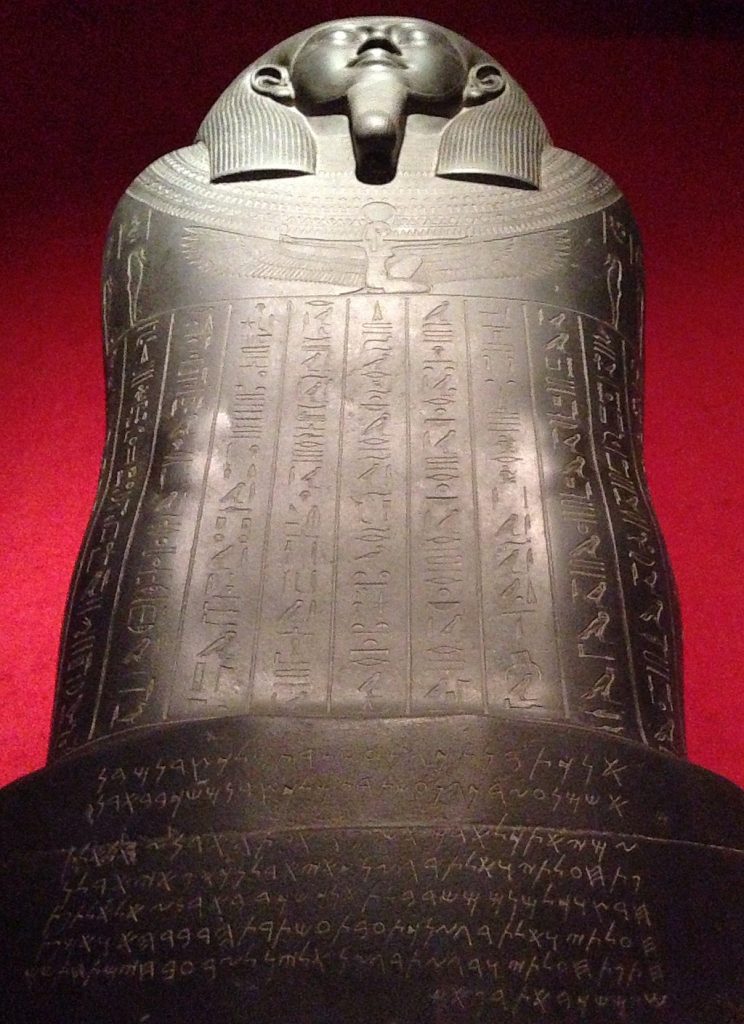
It looks like someone didn’t believe the curse because the sarcophagus was indeed opened, and the perfectly preserved body of the Phoenician King of Sidon, Tabnit I, was found in there in the original embalming fluid.
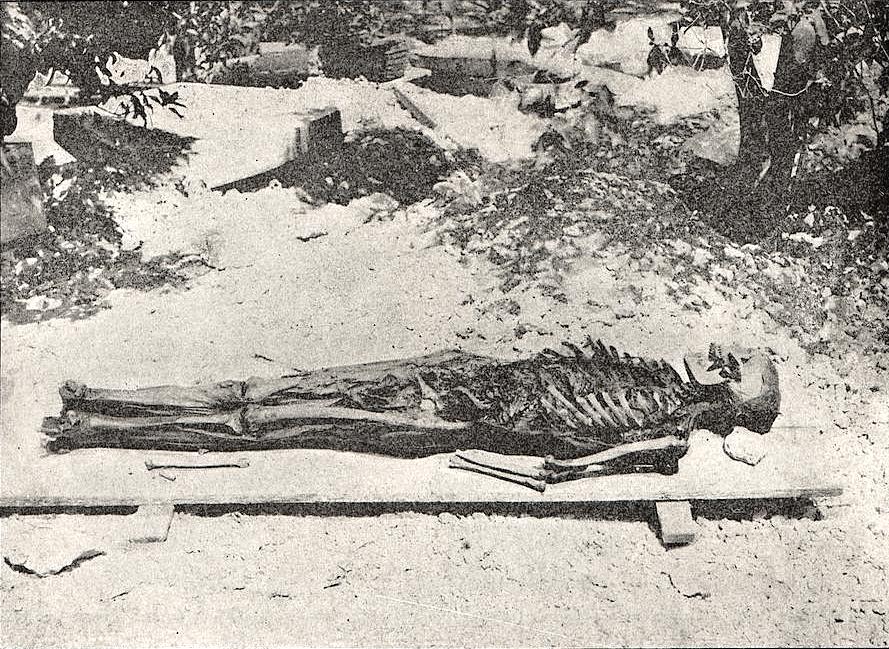
The story doesn’t say if it then rose, enslaved various NPCs, and tried to take over the world until Brandon Fraser & friends finally stopped him… but I’m pretty sure that’s how it happened.
The next sarcophagus is called the Lycian Sarcophagus, for its shape and general style which seem to come from the Lycia region of Ancient Anatolia.
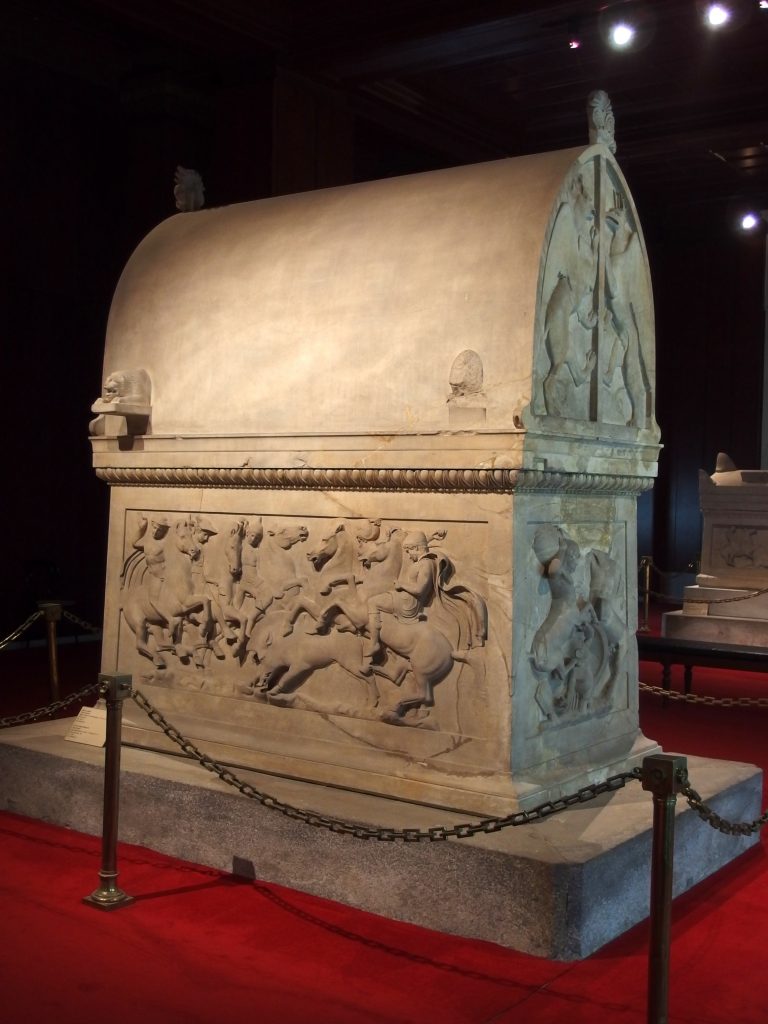
We were talking about royal hunting in a recent Journal issue, so note the bas-relief depicting what looks like a boar hunt. Other sides show a lion hunt and some fighting against centaurs and sphynxes. Obviously this king went to Beast Valley and got famous for it. I’ve got no idea if the sarcophagus had any remains inside, though.
Finally, there’s the Alexander Sarcophagus. Don’t get excited, Alexander wasn’t in there. But he was prominently featured on the bas reliefs, which leads to believe it might have been commissioned for him.
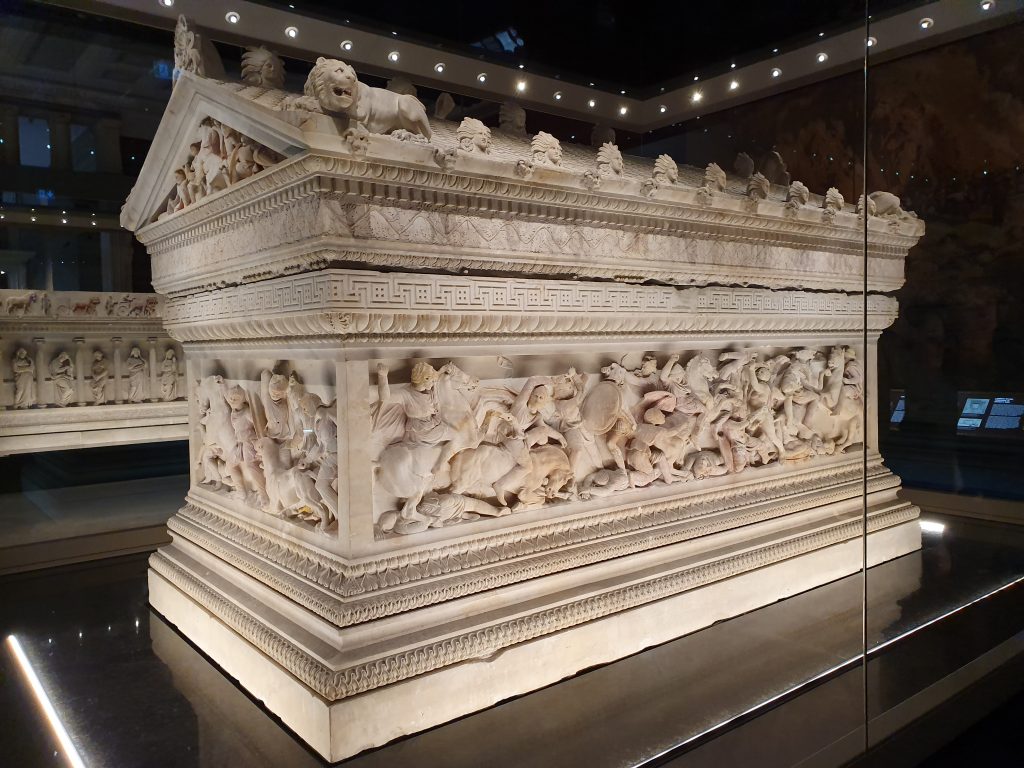
The scenes all around the sarcophagus feature many of Alexander’s military accomplishments… that’s why you track your characters’ Reputation gains: it’s so you can tell the sculptors and painters what to do!
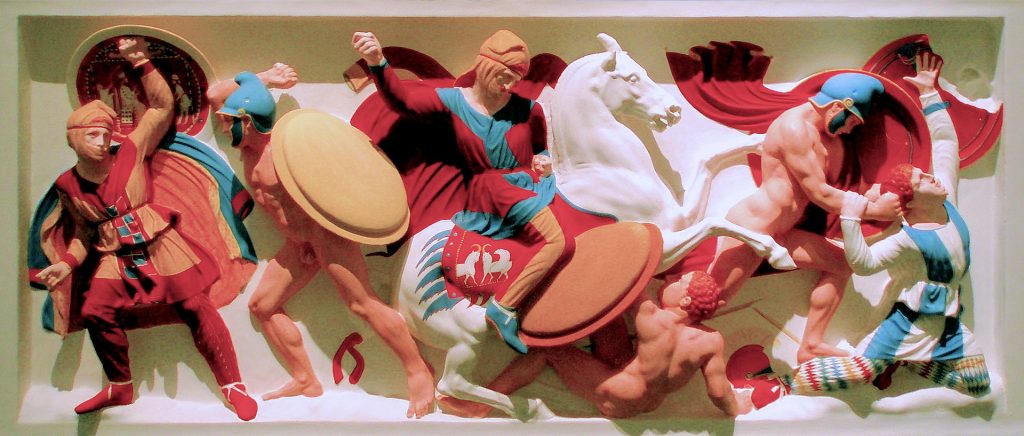
Here’s a colour reconstruction of one of the sides, based on traces of paint on the original. This is a good reminder to tell your players to fight naked once in a while.. err, wait, no I mean to remind your players to have their characters fight naked once in a while. Although, I guess, it could be both, frankly. That’s what X-Cards are for.
Griffin-Headed Demon
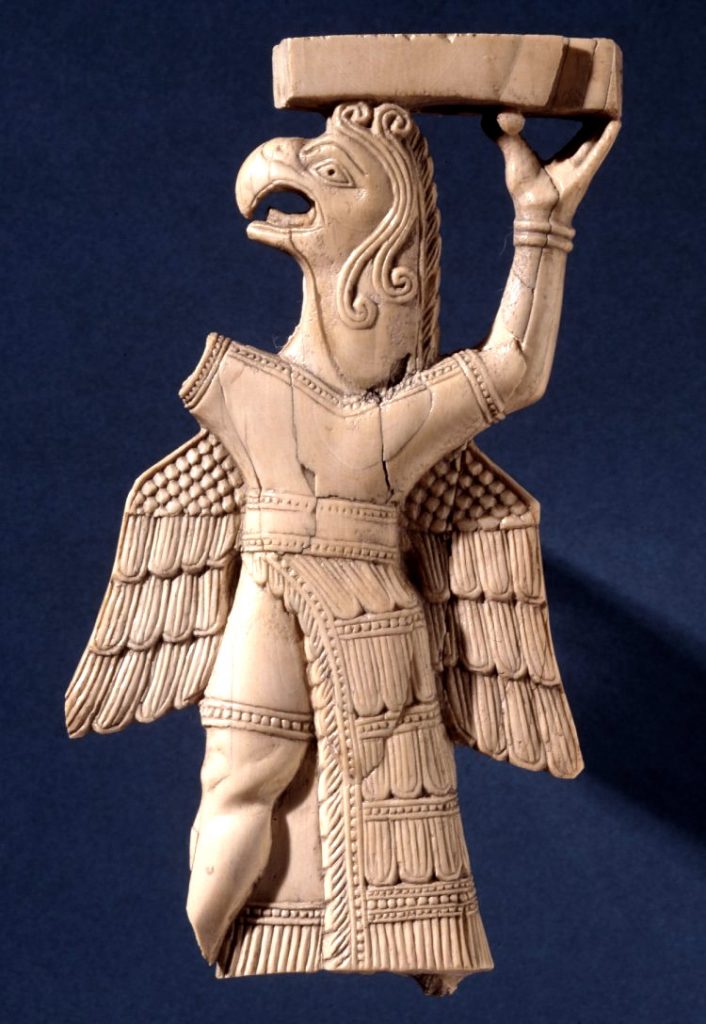
One last pretty picture: a “griffin-headed demon” figure made of ivory, dated 8th or 7th century BCE in Eastern Anatolia. It’s currently in the British Museum like, you know, most things that are totally not from Britain.
Thank you for reading
That’s it for this week! Please contact us with any feedback, question, or news item we’ve missed!




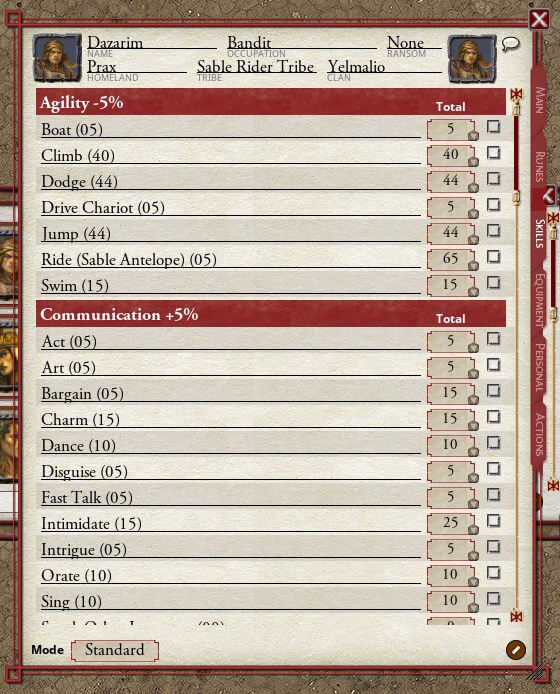
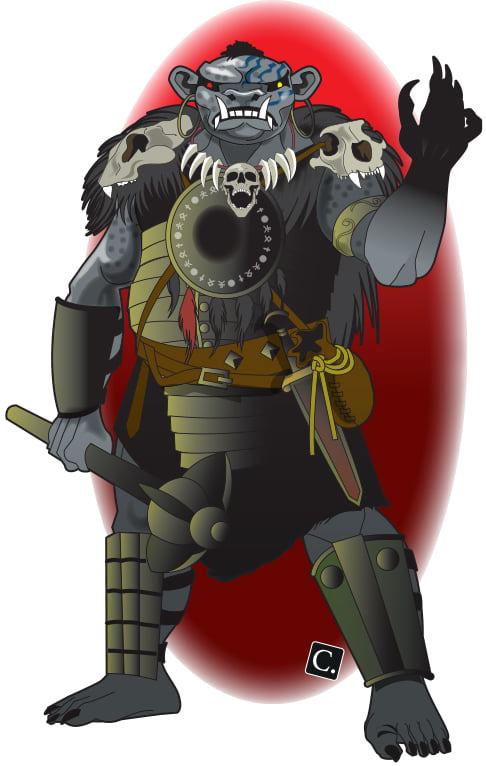
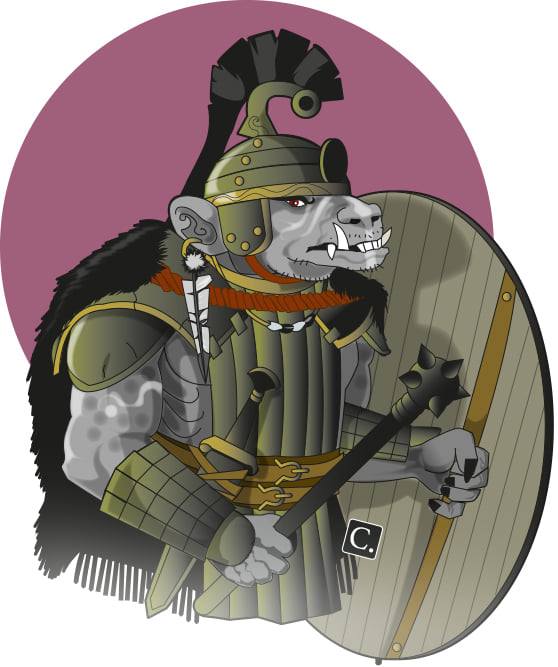
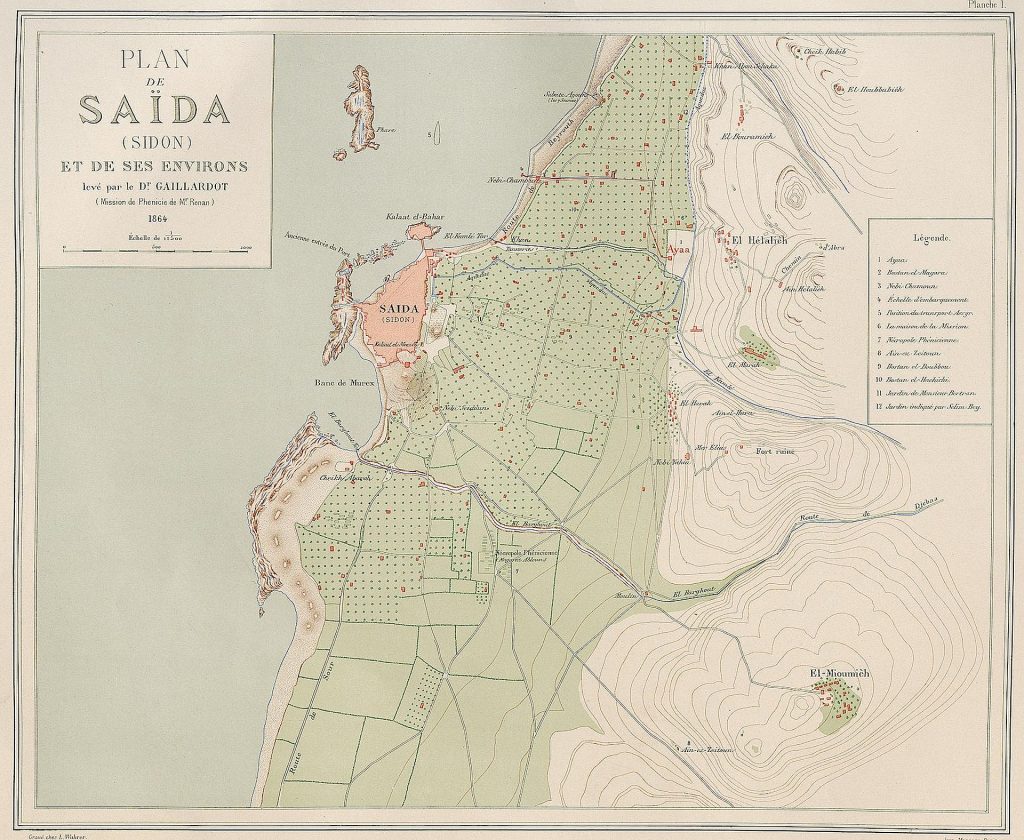
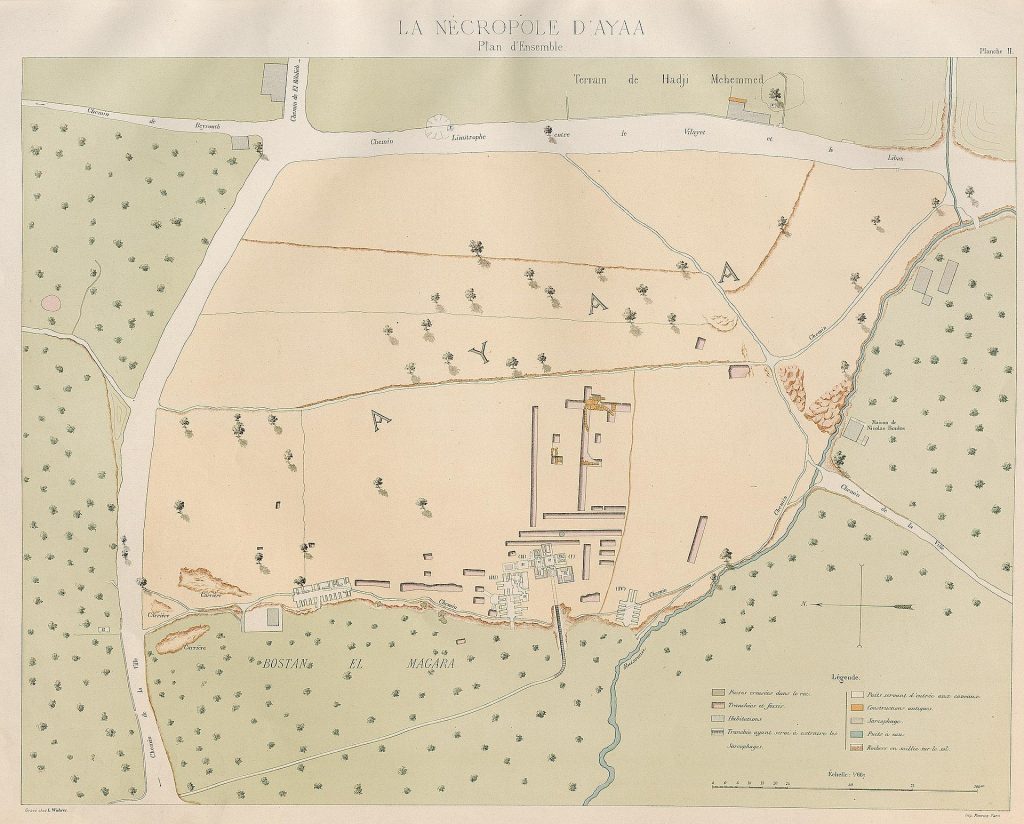
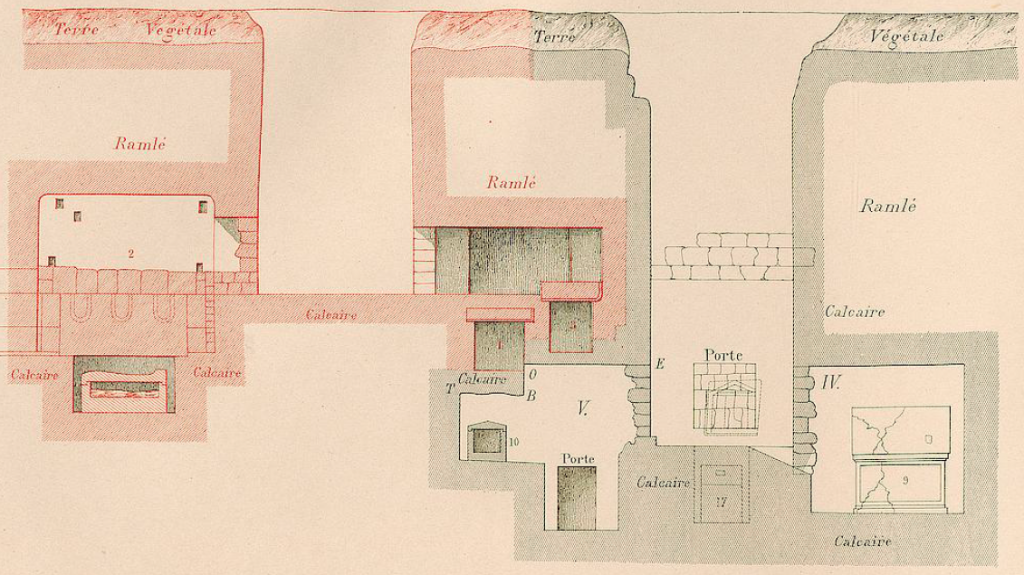
One comment on “Journal of Runic Studies #45”